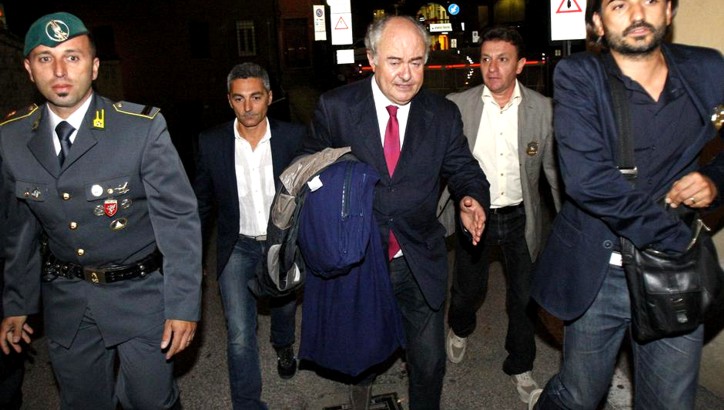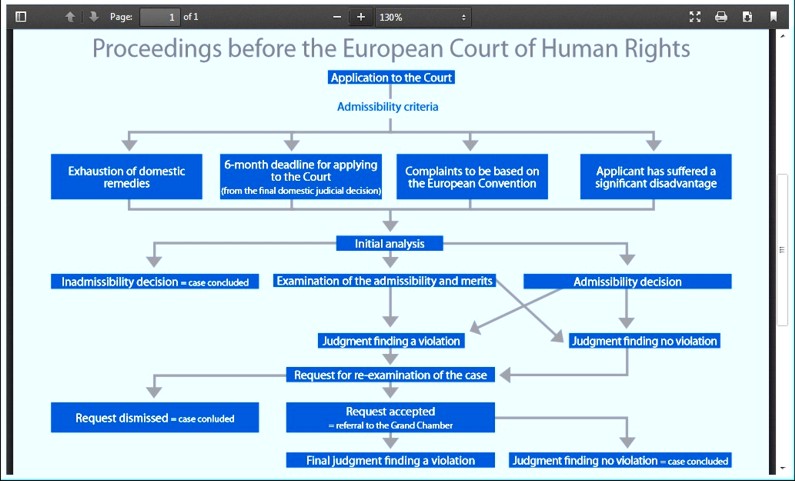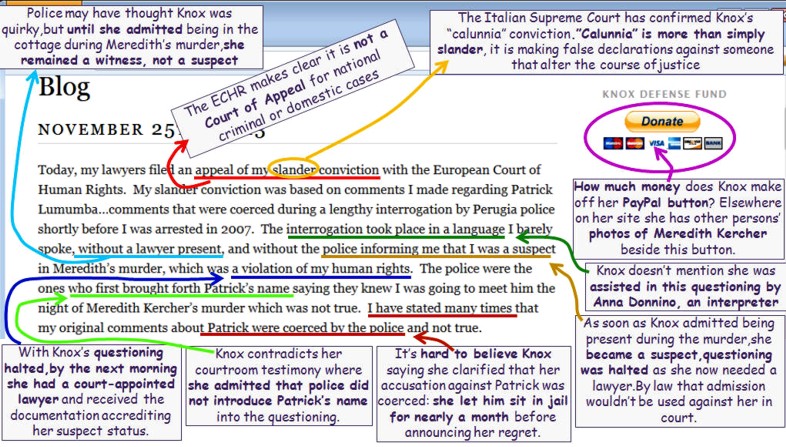
Category: The legal followups
Monday, April 07, 2014
Italy Pushes Back On False Claims In Sollecito Book: 20 Examples Of What He Must Defend In Court
Posted by Our Main Posters
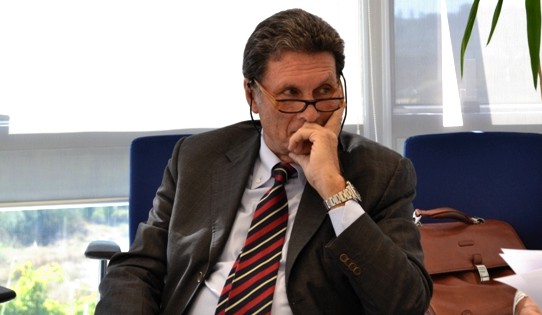
[Florence prosecutor Gianbartolomei will announce RS charges later this month]
Many posters contributed to this analysis and to what is to come. Special thanks to James Raper and Sara, and also to Vivianna, Yummi and Kermit.
1. Sollecito’s blood-money book gets published
Sollecito’s hapless book Honor Bound was released in English on 18 September 2012.
Within ten days all of Italy knew that the book was a crock.
Bruno Vespa, the persistent host of Porta a Porta, Italy’s most popular crime show (for the equivalent of which American TV cries out) forced Sollecito’s father in national prime-time to admit that at the core of the book was a huge lie.
Other claims about the case and the officials were shown to be wrong too.
Smarter people than Sollecito’s help in the US (Andrew Gumbel and Sharlene Martin, later John Q Kelly, and Simon & Schuster) might have put the brakes on until they got the truth straight and a revised version out.
But no, a media blitz was all ready to roar. The blood-money couldn’t wait.
Huge numbers of professional book reviews and Amazon reader reviews swallowed Sollecito’s claims in the book whole. The nastiness toward Italy and its justice system and officials was ratcheted onto a whole new plane.
2. Needless to say, official Italy did take note
For the legal reasons explained in this key post an investigation by the Florence Chief Prosecutor’s Office was mandated to begin.
In that same post it was warned that for the period the investigation would require, it would be taken below the radar, so that the Sollecito defense team would have no way to respond through dishonest PR or legal dirty tricks.
A not-unsurprising result of that stealth move was that in the meantime, in the last year, very full of themselves and feeling no constraint, Sollecito and his team went hog-wild in adding more crazy claims. And still more.
3. Now the investigation is complete
Now Prosecutor Gianbartolomei has issued his announcement of the conclusion of his investigation. The content of the notice is at present confidential except to the defenses.
As Yummi reports, from this point on, the defense has 20 days to say something, such as to request that Sollecito be interrogated or allowed to declare or explain something.
Then the prosecution will file charges against Sollecito and Gumbel, and possibly Sharlene Martin and Simon & Schuster, their careless publishers in New York.
Which precise false claims Prosecutor Gianbartolomei has made the target of his report we do not know. But this is a target-rich environment, that is for sure:
Consider for starters these 20 false claims which, believe it or not, all appear in the first seven pages of the book.
4. Twenty False Sollecito Claims
1. That Italian justice authorities took the easy way out
This is the story of two ordinary people who stumbled upon an extraordinary circumstance, the brutal murder of a British student in Italy. Neither Amanda Knox nor I had anything to do with the crime, but we came perilously close to spending the rest of our lives in prison because the authorities found it easier, and more convenient, to take advantage of our youth and inexperience than to mount a proper investigation. It’s that simple. And that absurd.
No advantage was taken of them. The two stood out very sharply from all the others of similar age, and of similar inexperience (whatever that means). They did and said dozens of things in the early days that set them sharply apart.
They were interrogated quite fairly, the Italian media was not especially hard, Dr Mignini never ever leaked, and they had lawyers and family handy at every turn after they were arrested. They each gave the authorities less than zero help - they tried to lead them off on wild goose chases, for example the false claim AK made against Patrick and dozens of other false claims, and apparently tried to finger yet another north African, Hicham Khiri, in a conversation they clearly knew was being recorded.
A “proper” investigation was indeed done. Simply read through all the posts on the trial here in the first half of 2009, and the prosecutor’s excellent summations, and you will see what a smooth comprehensive job was done. And the Supreme Court concluded that THREE had to have been involved, from the recreation of the attack and all the wounds on Meredith’s body. AK and RS and their lawyers never came within light-years of throwing real suspicion on anyone else.
2. That the preventive custody was very harsh
On November 1, 2007, Amanda and I were carefree students at the beginning of a cross-cultural love affair in a beautiful Umbrian hill town. Within days, we were thrown into solitary confinement in a filthy prison, without access to lawyers or loved ones, accused of acts so heinous and disturbing we may never be able to banish them from our thoughts, or our nightmares.
Raffaele was sent to preventative prison on Tuesday November 6. Capanne Prison was almost brand-new then, and far from crowded. Cells contain TVs and private bathrooms.
All questioning had been stopped early on 6 November until Sollecito could have a lawyer present. He himself wrote to his father in his “prison diary” on November 7: “I may see you tomorrow, at least that is what I was told by Tiziano [Tiziano Tedeschi, his lawyer at the time], who I saw today and who defended me before the judge.”
Mr Tedeschi made no complaint about any delay in the first meeting with his new client. In Italy, a judge must determine within 48 hours whether to hold or release detained suspects. Judge Matteini did so meticulously and refused his release.
3. That the prosecution and Italian media demonized the pair
In the newspapers and on the nightly news, we were turned into monsters, grotesque distortions of our true selves. It did not matter how thin the evidence was, or how quickly it became apparent that the culprit was someone else entirely. Our guilt was presumed, and everything the prosecution did and fed to the media stemmed from that false premise.
In the real world, the prosecution fed nothing at all secretly to the media and publicly very little, none of it self-servingly biased. Italian reporting was sporadic and very mild compared to anything one can see said daily about possible perps in the US and UK newspapers and on US TV. Besides, any coverage, which was in part deliberate in the situation as dozens of students were fleeing Perugia, had no influence on anything, neither on the investigation nor the trial.
The Italian system is set up so media can have less influence than almost any other media on any other justice system in the world. The Micheli and Massei sentencing reports show the judges were not unduly influenced even by the lawyers right in front of them, let alone by mild media reports 1 or 2 years before that.
4. That four years were wasted showing where the prosecution went wrong.
By the time we had dismantled the case and demonstrated its breathtaking absurdity [in the annulled Hellmann appeal] we had spent four of what should have been the best years of our lives behind bars.
“We” meaning the defense lawyers did very little in the annulled Hellmann appeal that they hadn’t flailed uselessly against in the trial. Except of course maybe shopping for an inexperience and pliable judge, and for DNA consultants who they could then spoon-feed. Much of the hard evidence they simply kept well away from in the trial and annulled appeal. Such as the extensive evidence in the corridor and bathroom and Filomena’s room, which were all considered parts of the crime scene.
On the other hand, RS’s claim could well apply to what Dr Galati and Cassation did for the Hellman sentencing report. Dismantled the appeal verdict, and demonstrated its breathtaking absurdity.
5. That Knox was made a target because timid Italy was scared of her.
Amanda and I certainly made our share of mistakes. At the beginning we were too trusting, spoke too frivolously and too soon, and remained oblivious to the danger we were courting even after the judicial noose began to tighten. Amanda behaved in ways that were culturally baffling to many Italians and attracted a torrent of gossip and criticism.
An inaccurate and xenophobic remark originated by the American Nina Burleigh, who was having severe culture shock of her own and surrounded only by other foreigners with similar mindsets. What EXACTLY was so baffling about Knox to the very hip Italians? That Knox was pushy, obnoxious, humorless, rather lazy, rather grubby, and not especially bright or funny or pretty? That she put off Patrick, Meredith, her other flatmates, the boys downstairs, the customers in the bar, and just about everybody else except for the distasteful druggie loner Sollecito?
Read this post by the Italian-American Nicki in Milan. To quote from it “As many of us were expecting, Amanda’s testimony has backfired. She came across not as confident but arrogant, not as sweet but testy, not as true but a fake who has memorized a script, an actress who is playing a part but not well enough to fool the public….. Amanda Knox is not on trial because she is American and therefore too “emancipated”....Italians don’t much like Amanda primarily because they perceive her as a manipulative liar, who is suspected of having committed a heinous crime for which there is a whole stack of evidence.”
6. That Knox and Meredith were really great, great friends.
We were young and naive, unthinking and a little reckless. Of that much we were guilty. But what we did not do””and could not have done, as the evidence clearly showed””was murder Meredith Kercher.
Meredith was Amanda’s friend, a fellow English speaker in the house they shared with two Italian women just outside Perugia’s ancient city walls. She was twenty-one years old, intelligent, and beautiful. She and Amanda knew each other for a little over three weeks, long enough to feel their way into their new surroundings and appreciate each other’s interests and temperaments. I never heard about a single tense moment between them.
Plenty of other people did know of tensions. Meredith’s family and friends all knew Meredith was finding the noisy dirty lazy loud unfocused Knox and her one-night-stands hard to take. Her other flatmates found her hard to take. Her employer Patrick found her hard to take. His customers in the bar found her hard to take. The Lifetime movie got this strident angle pretty straight.
Remember, Meredith enrolled for a full academic load at the main university. Knox in sharp contrast took only one undemanding language course - which anyone could walk into - requiring maybe 10 hours of study a week. They increasingly did less together. In fact after several weeks nobody was lining up to have anything to do with Amanda Knox.
Seemingly unable to reverse herself, she was headed to being among the least popular of students in Perugia. It should be recalled that the callous remarks by Amanda Knox about the death of her so-called friend Meredith included “Shit happens”, “She fucking bled to death”, and “‘I want to get on with the rest of my life”.
7. That an intruder knew about the rent money and so murder ensued.
Meredith, of course, suffered infinitely worse luck than we did: she came home, alone, on an ordinary Thursday night and had her throat slit by an intruder hoping to steal the household rent money.
There is zero evidence that this was the case. Knox herself ended up with a similar amount of cash that she has never been able to explain. There is zero possibility that Guede would know that any money was lying around - or not lying around, as it was concealed in Meredith’s drawer.
And take a look at the many images of the brightly lit house at night. There are several dozen other houses behind it in the dark which any smart burglar would have chosen first. In 2008 two real break-ins occurred at the house - both were in the dark behind the house, which is by far the easiest place to break in.
So much for the spurious lone-wolf theory, which Judge Micheli first ruled out even before trial.
8. That the media got hysterical and portrayed heartless killers.
But the roles could easily have been reversed. If Meredith’s Italian boyfriend had not gone away for the weekend and if Amanda had not started sleeping over at my house, she””not Meredith””might have been the one found in a pool of blood on her bedroom floor. That reality was quickly lost amid the hysteria of the media coverage. But it continued to hover over both of us””Amanda especially””as we sank into the legal quagmire and struggled in vain to overcome the public image of us as heartless killers.
There was zero media hysteria. This silly claim was addressed above. Watch the Porta a Porta YouTubes and dozens of other Italian reports and try to find ONE that is not fair and cautious and mature.
How precisely did the two struggle in vain to overcome their public image? By coming up repeatedly with stories which didnt even tally with others of their own, let alone with one another’s? They never between them made even one helpful statement which actually helped the police. And even their respective parents strongly suspected or knew of their guilt and were all caught incriminatingly on tape.
9. That Rudy Guede did it alone; ignore vast evidence that proves not.
This should not have been a complicated case. The intruder was quickly identified as Rudy Guede, an African immigrant living in Perugia with a history of break-ins and petty crimes. His DNA was found all over Meredith’s room, and footprints made in her blood were found to match his shoes. Everything at the crime scene pointed to a lone assailant, and a single weapon. Guede repeatedly broke into houses by throwing a rock through a window, as happened here, and he had been caught by the authorities in the past with a knife similar to the one that inflicted Meredith’s fatal wounds.
This is laughable. It has in fact been demonstrated in numerous ways that the attack involved multiple assailants and this was accepted by the Supreme Court.
Sollecito’s own lawyers never forcefully argued this. They produced two non-credible witnesses in the appeal trial (Alessi and Aviello) to actually prove that Guede had some other accomplices or that several others did it. Also Amanda Knox if anything diverted attention AWAY from Guede as he did in turn from her. He wasn’t quickly identified precisely because Knox had rather credibly fingered Patrick.
There is no proof Guede was an intruder. The trial court concluded Knox invited him in. Guede had zero proven history of break-ins or petty crimes or drug-dealing, and late in 2008 at his trial Judge Micheli became angry at such claims. Guede had no prior criminal record at all. He had only been back in Perugia for a few weeks, after an extended stay up north. His DNA was not found “all over” Meredith’s room. A major surprise, in fact, was how few traces of him were found.
The recreation of the crime scene and the autopsy both pointed AWAY FROM a lone assailant, not toward. From Meredith’s wounds, it was quite evident that two and perhaps three knives had been used, and not a single weapon. What lone intruder carries or uses two or three knives? And footprints in blood outside the door matched the feet of both RS and AK. This is why the Supreme Court confirmed Guede’s guilt only “in concorso” (with others).
10. That the cops could have caught Guede fast, despite Knox’s frame
Guede did not call the police, as Amanda and I did, or volunteer information, or agree to hours of questioning whenever asked. Rather, he fled to Germany as soon as the investigation began and stayed there until his arrest two and a half weeks later.
Guede’s apprehension and eventual conviction on murder charges should have been the end of the story. But by the time Guede was identified, the police and the public prosecutor’s office had convinced themselves that the murder was, incredibly, the result of a sexual orgy gone wrong, in which Amanda and I had played leading roles. Their speculations ignited a media firestorm, inspiring sensationalist headlines across the world about the evil lurking behind our seemingly innocent faces.
The authorities had no shred of evidence to substantiate this story line, only erroneous suppositions and wild imaginings. We had an alibi for the most likely time of death, and none of the initial forensic evidence tied us to the scene of the crime. Nothing in our backgrounds gave any hint of a propensity for violence or criminality. We were both accomplished, hardworking students known to our friends and families for our gentleness and even tempers.
Four more untrue remarks. All three were convicted of a murder with a sex-crime element and nobody was wrongly “convinced”. Which alibi is Sollecito talking about now? He himself admits in chapter 1 (Love and Death) that they had no “real alibi”. They still have no alibis at all for the second half of the evening, neither of them, when Meredith’s murder indisputably occurred.
Extensive forensic evidence within days tied them both to the scene. Not a single element of it has been discredited in the eyes of the Massei trial and Nencini appeal court. Not even one. Nothing was falsified.
Neither of their backgrounds was squeaky clean. Both had long been into illegal drugs, the loner Sollecito had to be watched by his father and teachers, the increasingly disliked Knox had a history of doing and saying crass off-putting things. Both were lagging behind their brighter peers in their studies and Knox was taking a year off.
11. That the prosecution fed the media a huge number of false claims.
Yet the authorities stuck to their guns. They fed the media a steady diet of sensationalist stories of how Amanda, the promiscuous American she-devil, and I, her sex-and-drug-addled Italian helpmeet, had tried without success to drag Meredith into our depravity and punished her by plunging an outsize kitchen knife into her neck.
Complete fiction. Again, in the real world, as the media reporters all confirm, the prosecution fed nothing at all secretly to the media, and publicly very little, none of it self-servingly biased.
Italian reporting was sporadic and very mild compared to anything one can see daily on possible perps in the US and UK newspapers and on US TV crime shows. There is zero sign this mild coverage mattered to the courts. As the media reporters all confirm, they were fed next to nothing by the police or prosecution on the case,
But whereas Mr Mignini famously never leaks, the defenses are widely claimed to have leaked throughout like sieves. So did Sollecito’s own family - they leaked an evidence video to Telenorba TV, for which they were considered for trial. Even we at TJMK and PMF received several offers of juicy leaks. Here is one example of where the Knox forces leaked - wrongly in fact - and then nastily slimed the prosecution and defenseless prison staff.
12. That the authorities had lots and lots and lots of scenarios.
It might have been funny if the consequences had not been so devastating. Listening to the tortured language of the prosecution””“one can hypothesize that . . . ,” “it is possible that . . . ,” “one can imagine that . . . ,” “this scenario is not incompatible with . . .”””it became clear that the authorities, like the media, were treating our case with the bizarre levity of an after-dinner game of Clue, or an Agatha Christie mystery. Everyone, even the judges in their black robes, had theories they were itching to air.
Have Sollecito and Gumbel ever before been in any other court in Italy or the UK or the US? Every judge and/or jury has to arrive at a scenario on lines not unlike this. That is the whole POINT of having courts - to weight the probabilities in what happened in the crime. The only difference in Italy is that the judges have to think their verdict through for weeks, and then write it all out, and then see it scrutinized by a higher court. This is hardly a requirement to be sneered at.
Gumble and Sollecito should have studied how US and UK juries arrive at their own scenarios. Very few US and UK lawyers think they do a better job. Ask those who watched the OJ Simpson and Casey Anthony trials and bitterly criticised the outcomes. And Italy has a vastly lower rate of false imprisonment than the US does.
13. That Italy is a medieval country with a primitive justice system.
It could have been Colonel Mustard in the drawing room with the revolver; instead it was Amanda and Raffaele in the bedroom with the kitchen knife. How was it conceivable that a democratic country known for its style and beauty and effortless charm””the Italy of the Renaissance and la dolce vita””could allow two young people to be catapulted to international notoriety and convicted of a horrific crime on the basis of nothing at all?
This is not remotely what happened. There was very far from nothing at all. Convictions in the US and UK regularly result based on evidence 1/10 or 1/100 of that here - sometimes from one single evidence point. Any one or several of maybe 100 evidence points here could have convicted them in a US or UK court.
Italy gives defendants every possible break, and the justice system is seriously loaded against victims and their families. Read here and here.
14. That the prosecutors office and media were in a grim embrace.
The answer has something to do with the grim embrace that developed between the prosecutor’s office and the sensationalist media. Like addicts constantly looking for the next fix, each fed the other’s insatiable appetite for titillation and attention. The casual cruelty of “Foxy Knoxy” and her Italian lover became too good a story line to abandon, even when it became apparent it was overheated and unsustainable. Our suffering was the price to be paid for the world’s continuing entertainment.
WHAT grim embrace? WHAT addicts? WHAT fix? WHAT insatiable appetite? WHAT titillation and attention? This is clearly defamatory if it can’t be proven, and we can turn up no evidence that any of it is true. It has to be one of the most foolish lies in the entire book, it is so easy to disprove. These who are being accused of crimes here are career police and prosecutors secure in their jobs, and none have the slightest gain to make from false convictions.
15. That in the justice system speculation and hearsay run rampant
The meandering complexities of the Italian legal system, where speculation and hearsay are allowed to run rampant and time invariably slows to a maddening trickle, did little to help our cause.
Total mischaracterization. First note that by comparison with any country in the world THERE IS NOT MUCH CRIME IN ITALY. There is some minor corruption and still some minor mafia action, but thefts and burglaries and assaults are few and murders even fewer. The main crime if you can call it such is not lining up to pay taxes. Italy’s murder rate is 1/6 that of the United States and its prison incarceration rate is 1/30 that of the United States, so where IS all this crime about which the claimed speculation and hearsay are running rampant?
The legal process could have been fully over by the end of 2009 if (1) there was not the entitlement to two automatic appeals; in UK and US terms there was very little to appeal about; and (2) the Hellmann appeal court had not been fixed to produce a corrupt outcome, as the displaced judge Sergio Matteini Chiari and Cassation and the Council of Magistrates have all made plain.
And compared to American police and prosecutors, their Italian counterparts are famously taciturn under their unusually firm rules. There is media interest, for sure, as there should be when there are crimes, but that also is comparatively restrained. Watch the various Porta a Porta shows on YouTube and you will see how sedate crime discussion tends to be.
The Constitution and judicial code set out to achieve the exact opposite of speculation and hearsay affecting justice, and they do so. Creating this restraint is a primary reason for the judges’ sentencing reports and all the magistrates’ checks of investigations along the way.
This whole series of dishonest claims about the the Italian system in the preface of the book and in a later chapter have clearly not been read through or okayed by even a single Italian lawyer.
16. That in Italy proof beyond a reasonable doubt scarcely exists
For reasons deeply embedded in the country’s history, the concept of proof beyond a reasonable doubt scarcely exists in Italy, and the very notion of undisputed fact is viewed with suspicion, if not outright aversion.
So Gumbel and Sollecito are historians and legal experts now? It would be nice, wouldn’t it, if either were able to explain the remark. This may be an ignorant swipe at the Napoleonic Code on which the law of a lot of continental Europe is based. Ignored is that Italy carried out its own reforms to the Code in 1990 and more subsequently. Much of that reform, it should be pointed out, was procedural or structural rather than substantive law.
There are two things wrong with “..the concept of reasonable doubt scarcely exists in Italy.”
1. It is factually wrong. Italian jurists, the courts, and so on, are well acquainted with the concept as it has been a fundamental aspect of criminal proceedings in Italy as elsewhere for many decades if not centuries.
2. It suggests that Italians are not intelligent enough to understand the concept anyway. That of course is an insult to Italians. Actually they are no less intelligent than the rest of us elsewhere who strive to understand it.
Until the 1990 Reforms the relationship between criminal and civil proceedings in Italy were governed by the principles of unity of jurisdiction and the prevailing status of criminal proceedings. Hence, if the facts were the same then criminal proceedings (to punish the guilty) and civil proceedings (to render liable the guilty for damages) were heard at the same time and still sometimes are, as in the Meredith Kercher case.
What has changed (relevant to the above quote) is that civil cases can be and are more likely to be heard independently from the related criminal cases and, where not, the standard of proof in civil cases (the preponderance of evidence or, as we usually refer to it, the balance of probabilities) is to be applied to the civil case, and the civil case only, rather than be confused with or overriden by the criminal standard of proof (beyond reasonable doubt).
Not an easy task, admittedly, to apply different standards to different tasks, based on the same facts, in the same proceedings, but Italian judges are trained to do this because that is their system. No judge would EVER confuse “beyond reasonable doubt” with “the balance of probabilities” when the issue at stake is depriving an individual of his freedom.
17. That the Italian judiciary has vast, unfettered powers
Few in Italian society wield as much unfettered power as the robed members of the judiciary, whose independence makes them answerable to nobody but themselves.
Radically the opposite of the truth. The paranoid claim reads like it came from ex PM Berlusconi fearful of his own conviction or one of his parliamentary lackeys such as Girlanda.
The checks and balances on judges in the Italian system are enormous, perhaps the toughest checks and balances in the world. Read here and here about them.
All of the best judges in the world are independent and they all follow a demanding career path, not elected (as ex-Judge Heavey was) under zero criteria, or appointed under the political sway of politicians. We wonder if Gumbel and Sollecito have ever heard of the US Supreme Court? Do those judges answer to anybody? No? How unfettered.
18. That the courts are the most reviled institution in Italy.
Many Italians retain a healthy skepticism about the reliability of their procedures and rulings. The courts””tainted by politics, clubbishness, pomposity, and excruciating delays””are the most reviled institution in the country.
As our Sollecito Book pages make clear again and again and again, the Italian system is remarkably NOT tainted by politics, as even the most surperficial watcher of the trials of ex Prime Minister Sylvio Berlusconi would know.
And on the issue of popularity we have previously posted this and this and also this.
Our Italian poster Machiavelli (Yummi), who posted our deep analysis of the appeal to the Supreme Court by Dr Galati, has provided these hard facts:
For comparison, in 2011 the percentage of Italians who declared they trust the justice system “a lot” or “enough” was 53.3%. By comparison, the percentage of Italians who declared they trust the government “a lot” or “enough” were 14.7%, and those who trust the parliament were only 15%.
In 2012, the percentage of Italians who trust the parliament is now only 9.5%, and those who trust the Mario Monti administration are only 21.1%.
Over the eight years from 2004 to 2012 the percentage of Italians who trust the justice system was always bigger than those who trust parliament or government by at least ten points, and in some years we can see a spread of 20, 30, even 39 percentage points achieved by the judiciary over the parliament and government.
However, some cases of corruption (such as our Hellmann-Zanetti case, but also several others indicated by the Rapporto Italia 2012) do hamper trust.
The most trusted institutions in Italy above all are the Carabinieri (74% of Italians trust them) and the Polizia di Stato (71%).
Which means the most trusted institutions are precisely those law enforcement instruments which are deployed to enforce the orders of prosecutors.
19. That prosecutors can spin their cases into any shape they please.
Because the Italian legal system is almost completely blind to precedent and relies on a tangle of impenetrable codes and procedures, prosecutors and judges have almost boundless freedom to spin their cases into any shape they please and create legal justifications on the fly. Often, they are more interested in constructing compelling narratives than in building up the evidence piece by piece, a task considered too prosaic and painstaking to be really interesting.
Whoever wrote this either wasnt an Italian or a lawyer, and either way didnt have much of a clue. The entire Italian system under the post WWII constitution was designed to PREVENT what Sollecito & Gumbel claim it allows here.
There are checks and balances and reviews every step of the way. Magistrates (initially Matteini here) determine what a prosecutor may do in developing and presenting a case. Parties may appeal to the Supreme Court AT ANY TIME as Knox’s lawyers did over her second written confession - which she herself had demanded to make in front of Dr Mignini after he finished warning her of her rights.
Hard for Sollecito & Gumbel to believe, perhaps, but the defense is actually present in the same courtroom. They can raise points of order at any time. So can the defendants themselves, at any time, something maybe unique in the world.
And judges actually have minds of their own. And then there are the unique written sentencing reports, and the two automatic appeals if any parties want to pursue them.
Sollecito & Gumbel should have read the 2012 Galati appeal more closely. The Prosecution’s Appeal To The Supreme Court is available in English here. Precedent has a section to itself - “The non-observance of the principles of law dictated by the Cassation Court in the matter of circumstantial cases (Article 606(b)) in relation to Article 192 paragraph 2 Criminal Procedure Code.”
Well, that’s precedent, via the Court of Cassation no less! How surprising from Gumbel/Sollecito that they should make that claim about ignoring precedent when in fact there it is, going right to the heart of the flawed Hellmann/Zanetti judgement on circumstantial evidence! What else is a Code but in effect a codification, a gathering together, a rationalisation, of best law - and precedent?
There is an absurd irony here, were they aware of it. Perhaps they are. Surely it is Hellmann and Zanetti who have displayed “a boundless freedom” in spinning the case “into any shape they please”, and who have “created legal justifications on the fly”? As for prosecutors doing this, at least Dr Mignini followed the evidence, and American readers may recall the infamous Jim Garrison, the DA hero of Oliver Stone’s movie “JFK” but who in reality, unlike Dr Mignini, was a total and utter crackpot.
And what issue exploded the Porta a Porta TV show in Italy in September 2012? It was Sollecito’s false claim that the prosecution had secretly tried to offer him a deal if he would roll over on Knox. NOBODY including his own father and his own lawyers confirmed him. Evidence against both was overwhelming. Nobody needed such a deal, and Italian prosecutors are highly rules-bound against ever offering such deals.
Sollecito was in effect accusing Dr Mignini of a felony with this much-repeated false claim in his book. (In her book Knox also accused Dr Mignini of a felony.)
20. That the prosecutors and judges in Italy are far too close.
Prosecutors and judges are not independent of each other, as they are in Britain or the United States, but belong to the same professional body of magistrates. So a certain coziness between them is inevitable, especially in smaller jurisdictions like Perugia.
Yes, prosecutors and judges in Italy belong to the same professional body of magistrates. But then so does the defense lawyer Ms Bongiorno. The claim that there is no independence between prosecutors and judges in Italy, in fact a coziness between them, is a bit rich.
Consider, say, the UK. It is true cases are prosecuted by the Crown Prosecution Service, a government body, but in serious cases the CPS will employ barristers from the Inns of Court. There is scarcely a judge in the UK, even up to the highest level, who was not and who is not still a member of one of the Inns of Court from whence barristers, for the prosecution or for the defence, ply their trade.
You can’t walk past an Inn without seeing the names of judges on the roll call on the plaques outside. A judge is still a barrister, just fulfilling a different function, although, of course, now paid by the State. The old school boy tie? Corruption? No, the fulfilling of different roles by members of the same body is called professionalism.
Judges and lawyers all belong to the American Bar Association in the US and attend the same conferences. No sign that this lack of “independence” ever affects trials. This claimed excess of coziness is often ranted about online by the Knoxophile David Anderson who lives near Perugia. Nobody who pays him any attention can get where he derives this from. Maybe he heard it from Hellman?
Perugia prosecutors and magistrates are all known to do a fine job, and the national Olympics & earthquake relief cases involving powerful Rome politicians were assigned for competent handling to where? To Perugia… Defense lawyer Ghirga and Prosecutor Mignini have the reputation of being good friends. And Mignini and Massei would both draw their salaries from the State. But so what? Do not judges and DAs in the the USA do likewise? Are Gumbel and Sollecito impugning the professionalism of the counterparts of Mignini and Massei all over the world? It sure reads like it.
5. About Relevant Forthcoming Postings
Akk of this above analyzes only the first seven pages, out of a book which has several hundred pages. We will post one or two times more during April. Later in the book, there is a lot of venomous sneering addressed at Dr Mignini, although his performance at trial was excellent - and he is now for Perugia’s region (Umbria) the Deputy Prosecutor General.
In Italy Dr Mignini is now and then on national TV along with Michele Giuttari, who pursued the main Monster of Florence theory - not the crackpot theory Preston and Spezi attempted to use to frame someone. At impugning him, Sollecito and Gumbel have failed miserably, and for that are now in the crosshairs of the system.
*******
Many posters contributed to this analysis and to what is to come. Special thanks to James Raper and Sara, and also to Vivianna and Kermit.
[Kermit’s take on Katie Couric, one of several smart TV hosts who suspected a giant con]

Friday, April 04, 2014
The Florence Chief Prosecutor’s Office Announces That Sollecito Will Face More Court Action
Posted by Our Main Posters
Breaking news from Main Poster Yummi
Prosecutor Gianbartolomei has issued a notice about the conclusion of his investigation. The content of the notice is confidential for the defenses.
From this point the defense has 20 days to say something, like to request that the defendant (Sollecito) is interrogated or has anything to declare, or to submit any documents if they want to.
Then, once the 20 days are expired, the prosecution will file charges.
Since the charges will include almost certainly, beyond aggravated defamation, also contempt of the Judicial organs, the prosecution may send a notice to the Ministry of Justice too.
Since they are victims of contempt they may appoint a plaintiff.
The senior Florence prosecutor Dr Giuliano Giambartolomei was assigned to investigate the claims in Sollecito’s “Honor Bound”.
Today he announces that his findings indicate that many claims are spurious and justify new charges being brought against Sollecito. Shadow-writer Andrew Gumbel, who recently published this self-incriminatory rant has also been named.
When the charges are filed several or some others who have been assiduously “helping” Sollecito (mostly for big bucks) such as book-agent Sharlene Martin might find themselves named also
So Sollecito for sure and Knox most probably will be confronting the often-contradictory claims in their books, and saying whether they accept or reject each of them, which should put other book-writers who made false claims on the spot and maybe wind the whole FOA effort down.
We will be making our separate page on Sollecito’s various false claims live again. Main posters have posted a large number of corrections to Sollcito’s claims in the book. We have been putting them in correct page-order.
Miriam has kindly contributed this translation of today’s report in Il Messagero. Dr Giambartolomei only hints to the reporter what will be in his report which will quote all the passages in full for which Sollecito will have to account.
Raffaele Sollecito Insults The PM And A New Trial Starts
As always everything [possible] is presumed and as always, in the case of the murder of Meredith Kercher, everything [possible] can be overturned at every verdict.
Even in the associated trials, such as the one for defamation (against PM Mignini) and contempt (against the police) for which Raffaele Sollecito, found guilty of the murder of Meredith Kercher along with his ex-girlfriend Amanda Knox, is being investigated along with the British journalist-author (now in absentia) Andrew Paul Gumbel.
Defamation, because many parts of the book “Honor Bound”, of which both are authors, contains for the prosecution various ignominious remarks.
More than simple phrases, entire chapters (allegedly) of the book are written in what is technically called “conclusione delle indagini” and requires the matter to be brought to justice, and therefore to trial.
[The book] starts by summarizing the main evidence (that was then proved to be wrong by the facts) against Sollecito.
The two being investigated write: “ the main proof that Mignini had to bring to the preliminary hearing were my Nikes… and he did everything possible to render them more incriminating…”
Then again “the police had only the pictures of my shoes (not those of the print) and in some way they came to the conclusion that my Nikes were the same brand, model and size as the shoeprints on the floor of Meredith’s apartment. There was no doubt about this”
Then the facts demonstrated that the shoe prints where of Rudy Guede, the third person condemned for the murder of the British student, and could not be those of Sollecito, because of the size.
Therefore this touches on the management of the trial on the part of Mignini. Sollecito-Gumbel write: “one of the reasons that our hearings were so distant one from the other was that Mignini was fighting his own separate legal battle for abuse of investigated activity.”
This connection goes to the case of the death of the Perugian Doctor Franceco Narducci, connected to the Monster of Florence case which Mignini had investigated.
Sollectito sustains: (defended in this case by Alfredo Brizioli) “I think our case, among other things, was a big diversion to keep the media’s attention away from the legal battle Mignini was having in Florence, and to give him the victory in a high profile case he so desperately needed to restore his reputation.”
The young Pugliese continues: “”¦..just as he did in the Monster of Florence case, Mignini used every instrument at his disposal against his critics and adversaries. The avalanches of legal action by part of Mignini had an inevitable icy effect , especially on the Italian press and this played a clear role in turning the public opinion against us.”
The charges against Sollecito and Gumbel are those of having sustained that it was Mignini’s idea to seek to obstruct the investigation as is from the beginning, it was a studied act to bend the investigation and turn the trial to his side.”
This is a clear accusation in the eyes of the prosecutor Giuliano Giambartolomei: “His approach (Mignini’s), Sollecito is saying, was particularly vindictive…. This is enough for Sollecito to face charges of defamation.”
Important to note that Dr Giambartolomei does NOT explain here precisely what will be in his report. That will have to quote all the passages in full for which Sollecito may have to account. Then he or whatever prosecutor charges Sollecito will go to another depth.
With our analysis of the book and knowledge of Italian law we can probably pick many or most of the false claims made which impugn officals or the Italian system.
More posts coming. Stay tuned.
Saturday, March 29, 2014
Silicon Valley Lawyer Richard Dwyer Mulls Knox Fingering Patrick, Also Dewani Killing Wife
Posted by Peter Quennell
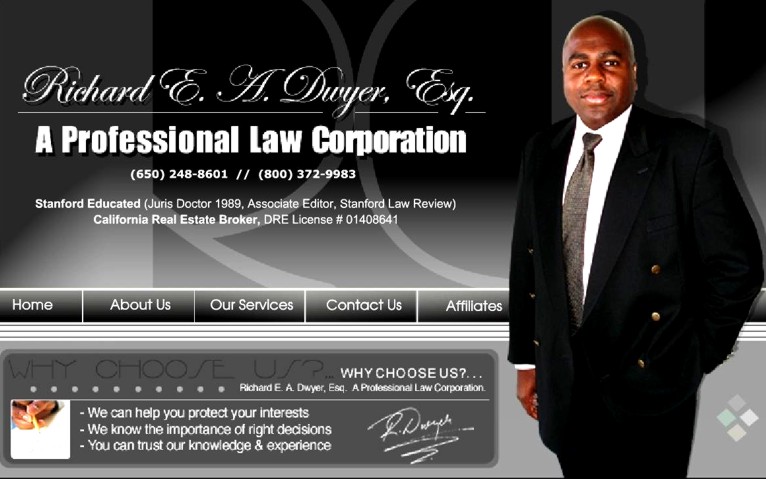
Richard Dwyer is known as a very, very smart Silicon Valley lawyer. He is a Stanford Law School graduate. Using Skype he has posted a lot of astute video analysis online.
Below Mr Dwyer comments with cold precision and a significant depth of detail on the matter of Amanda Knox framing Patrick (15 minutes) which he sees as in itself all an America court could need to find for guilt.
In the second video below he comments on the strong case that South African justice has against Shrien Dewani for killing his wife (50 minutes) to which several posts of ours immediately below refer..
Wednesday, January 15, 2014
Mignini And Giuttari Win Final Round In Spurious 2010 Conviction By Rogue Prosecutor And Judge
Posted by Peter Quennell
Poison pill sown in 2006
The entire edifice of the Knox PR campaign was always built on a foundation of sand.
Years ago, the wannabe real-crime-reporter Doug Preston was shaken to the core when Dr Mignini and others figured out with the help of court-authorized wire-taps that he and Mario Spezi were planting evidence and using fake IDs to frame someone they had wrongly concluded was the “real” murderer in the Monster of Florence case.
In uncalled-for retaliation (he got off very lightly and could have faced a prison term) Preston went back to the US and, safe there, wrote a nasty and largely fictional book. He repeatedly claims it was really the cops and specifically Dr Mignini not Preston & Spezi who were dumb and blundering in not sufficiently investigating and charging the “real” murderer.
Fast-forward to 2008
Almost nobody in Italy supports Preston’s and Spezi’s “solution” to the MOF crime which they seemed to hope would bring them big bucks and whole new careers. That solution is widely regarded as a joke and there is voluminous evidence against it.
Nevertheless, Preston’s MOF book is published in the US, demonizing Mignini in great detail.
Knox PR aide David Marriot and his media pet poodles and online thugs, including the wild-eyed Paul Ciolino of CBS and the bizarro Frank Sforza of Perugia, were all over the notion that it was Mignini and not Preston & Spezi who had done something seriously wrong.
The mafia always has an interest in taking Italian justice down a peg, and opportunities were increasingly seen here. The mafia’s various useful idiots in the US (John Douglas, Saul Kassin, Dempsey, Burleigh, Steve Moore, Michele Moore, Heavey, Fischer, Doug Bremner, Hampikian, Halkidis, and some others) who have plagued a correct understanding of the MOF and Perugia cases all helpfully all piled on.
Fast-forward to January 2010
Dr Mignini and the former head of Florence detectives Michele Giuttari were convicted in Florence on spurious grounds. See our posts back then by Commissario Montalbano and TomM.
The purpose of the Florentine investigation against Mignini and Giuttari was obviously a pretext, a ploy aimed at blocking the seemingly very threatening Narducci arm of the MOF investigation. In fact it was a pretext for the rogue Florence prosecutor seizing the Narducci case file back from Dr Mignini in Perugia and burying it out of sight.
Nevertheless, the demonization of Mignini became even more shrill, multiplied globally by the gullible Joel Simon of the New York-based Committee to Protect Journalists in foolishly protecting the proven liar Frank Sforza who is now facing THREE trials.,
Fast-forward to November 2011
The Florence appeal court reverses the 2010 convictions because the case was brought by the SAME rogue Florence prosecutor who was caught on tape meddling in the Narducci investigation and who was one of those (there were others) trying to slow it down or destroy it.
Fast-forward to January 2013
The Supreme Court scathingly endorses that reversal. The attempt from within the Florentine court to de-legitimize the Narducci arm of the MOF investigation was from now on definitively at a dead end.
The investigations and trials of those who had for mysterious reasons been hampering the Narducci investigation were also put back on track by Cassation. Most threatened is Doug Preston’s mate Mario Spezi. He seems headed for a prison sentence for sure, leaving Preston (a major meddler in Meredith’s case) also legally very exposed..
Fast forward to April 2013
Dr Mignini is promoted, gaining very high marks in a competitive process. From this point on he will handle only appeals, and when Dr Galati retires (expected soon) Dr Mignini is expected to be the #1 prosecutor of the Region of Umbria.
Fast forward to summer 2013
The Turin prosecution office finally obtains the investigation file on Mignini and Giuttari from Florence as the Florence appeal judge and Cassation had instructed.
The investigation file should have been sent in November 2011 for action leading to full closure on the substance, but the Florence prosecutors illegally sat on it, presumably fearful of what could happen to him.
The Turin prosecution office had little interest in re-opening what seemed a dead-end and frivolous case. If this was what Mignini and Giuttari had wanted, the charges could have been dropped, but without any court finding of “not guilty”.
However, Dr Giuttari and Dr Mignini explained that they wanted a court finding of “not guilty” on the merits of the case. They WANTED the Turin court to read the evidence and to make a final ruling.
Fast forward to today
The Turin court did meet. Andrea Vogt posted this report.
For those keeping track of the various “sideshows” in the Amanda Knox case, a Turin court Wednesday definitively acquitted Perugia prosecutor Giuliano Mignini of three charges against him in connection to his investigations into the Monster of Florence case. The court shelved another three charges because the statute of limitations had expired. One abuse of office charge involving the wiretapping of a La Stampa journalist will be heard in court on March 18, but its statute of limitations appears to expire just days before, so it is unclear if the case will go forward. None of the matters relate directly to the Amanda Knox case, but they were often referenced by the prosecutor’s detractors.
And what next
The Italian justice system protects its senior judges and prosecutors from criminal defamations intended to obstruct justice with some powerful measures. They were originally intended to keep the mafia in its place as defamation of police, prosecutors and judges is one of its mainstays.
All of the false claims about Dr Mignini are still out there. Preston’s book is still on sale. So is Burleigh’s, Dempsey’s, Fischer’s, and John Douglas’s. Joel Simon’s seriously wrong claims are still online. Not one has recanted or wound back.
Knox and Sollecito each repeated the baseless claims at length in their books, and even embellished them. Michael Heavey parrots them to the State Department. They are the main crutch of Bruce Fischer, Steve Moore, Michele Moore, Doug Bremner, and so on.
However, the required pushback by Florence prosecutors and others has begun, and with today’s ruling will accelerate. Frank Sforza is already on trial for calunnia and the Italian justice system is quietly zeroing in on many others, all the book publishers included.
On March 14 the magazine Oggi which published many of Amanda Knox’s baseless claims in Italian must appear in court in Bergamo. Knox and Sollecito themselves may find a heap of new legal troubles after the appeal verdict is announced on 30 January.
*****
Numerous posts by Kermit and Yummi still need to be linked to.
Monday, January 06, 2014
Curious Parallels Between Scott Peterson And Amanda “I Am Not A Psychopath” Knox
Posted by giustizia

[Above: Laci Peterson and Meredith Kercher, the victims in the two cruel crimes]
1. The Violent Deaths Of Laci Peterson and Meredith Kercher
Laci Peterson was soon to give birth in California in December of 2002. On Christmas Eve, her husband Scott reported her missing. In April of the following year, her body and the body of her unborn son Connor were discovered in the San Francisco Bay.
Five years later, in Italy, on 2 November 2007, foreign study student Amanda Knox was at her rental home with her Italian lover Raffaele Sollecito in Perugia, Italy, when the postal police arrived early one morning to return some cell phones traced to her flatmates; the phones had been found dumped in a nearby garden.
Shortly after, the shocking discovery was made that her flat mate Meredith Kercher had been murdered.
2. Parallels Between Knox and Peterson In Their Personalities, Crimes And Court Cases
There is a number of striking parallels between the behaviors of Amanda Knox and Scott Peterson and their alleged crimes and convictions.
The horrific murders of two beautiful young women (one almost at the end of the full-term pregnancy of her first child) unleashed in each case a maelstrom of publicity rarely seen in search of the murderer.
When arrests were made, there also came the stunning revelation in each case that the accused was well-known to the victim ““ in Laci’s case, it was her husband, Scott Peterson; in Meredith’s case, it was her roommate, Amanda Knox.
Ultimately, three people were arrested for the murder of Meredith (as we know, the fourth person arrested, Patrick Lumumba, falsely accused by Knox as Meredith’s murderer, was released when his solid alibi was proven). Of the three people arrested for the murder of Meredith Kercher, evidence suggested to prosecutors that Amanda Knox was the instigator of the crime.
In each trial, the defendant presented a seemingly normal and middle-class appearance. Neither defendant had a significant history of violence or widely-obvious mental illness. Their families insist on their innocence.
Yet both were convicted of brutal murders (and both now fight their convictions on appeal).
Knox and Peterson were each described by casual acquaintances, neighbors and friends as nice, regular people.
Ann Bird, Peterson’s half-sister, described him as being “charismatic, charming, courteous, polite.” On Dateline NBC television, a friend of Amanda Knox described her as being “generous, kind, genuine, optimistic, bubbly. Pretty much all the good words that you can find in a dictionary, she was.”
But they proved superficial assessments that in fact really only scratched the surface.
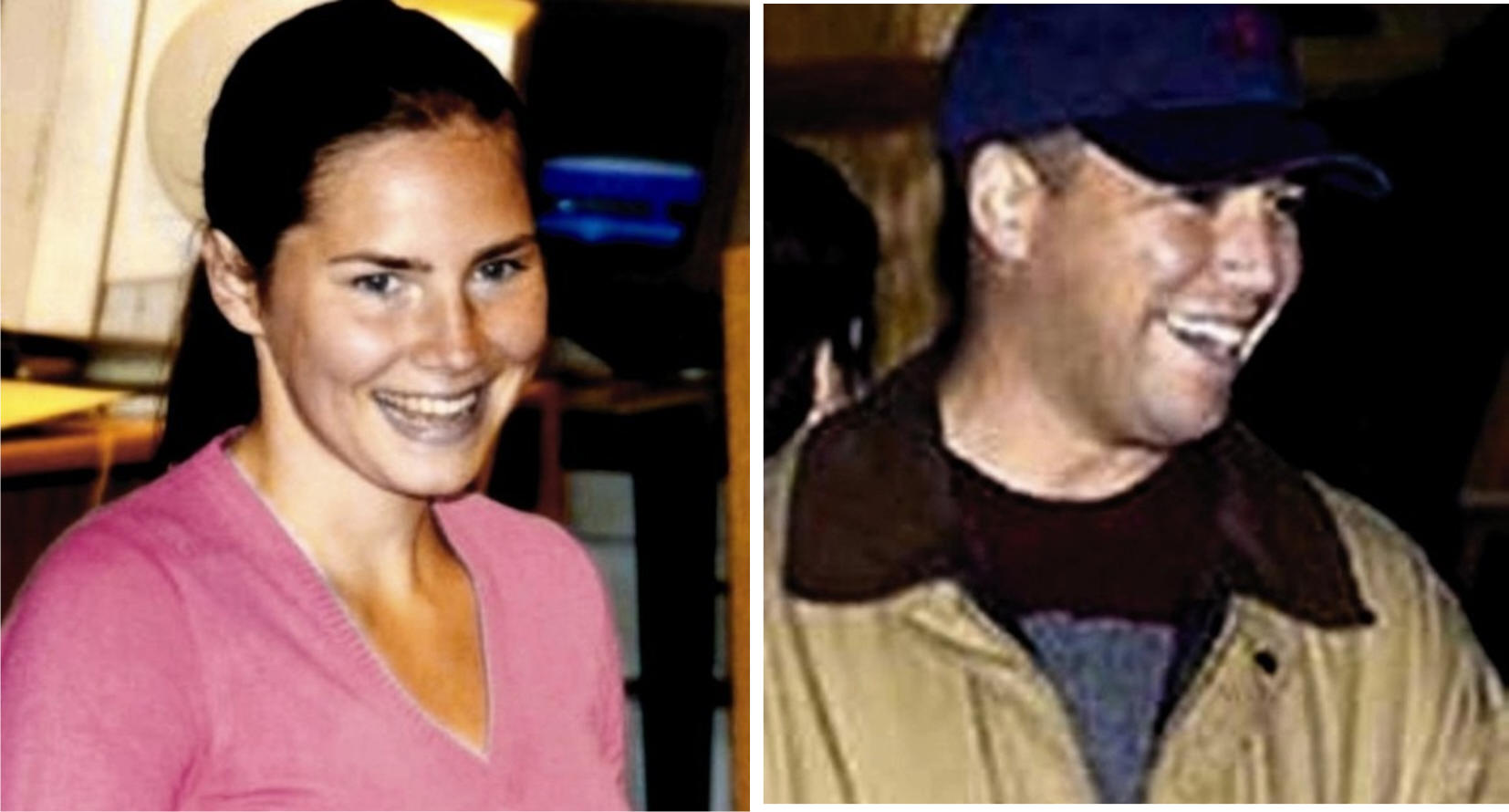
3. Reckless Odd Behavior And Lies By Amanda Knox
Amanda Knox had been cited and she had received a fine (a sentence which could have been more severe) for disturbing the peace and throwing rocks at a party in Seattle shortly before her departure to Italy.
Knox abruptly and without clear reason dropped a much-sought-after internship in Berlin, Germany, before arriving in Italy.
She posted a vignette on Facebook about a sexual liaison she had with a stranger, a middle-aged man, while on a train in Italy.
Her roommate Meredith had become increasingly disenchanted with the American flatmate who brought home different men without warning. “So she’s [Meredith] waking up in the morning and there’s someone making tea. And it’s, who are you again?” commented Meredith’s friend Brittany Murphy on the subject of Meredith’s unease at the strangers Knox brought to their rented Italian home.
Richard Owen, the Italy correspondent of the London Times in Italy, who has written multiple stories on the case, stated that Knox brought home “people who Meredith Kercher distrusted. Didn’t like the look of. It got to the point where she actually confronted Amanda about this.”
And Amanda Knox’s behavior after the Meredith’s murdered body was found in their rental home was more than atypical for someone who had their flatmate killed in such a horrific fashion in such close proximity.
- “As she put them on she swiveled her hips, pulled a face and said ‘hop la’ - I thought it was very unusual behavior and my suspicions against her were raised.” (Edgardo Giobbi, a police forensic scientist, testifying in court, describing Knox’s behavior just hours after the murder, after he handed Knox a pair of shoe-covers to prevent contaminating the evidence during a search of the house. Sky News, UK, May 30, 2009.)
- “While I was [at the police station] I found Amanda’s behavior very strange. She had no emotion while everyone else was upset. I remember one thing that really upset me. [Meredith’s friend] Natalie said, ‘I hope she wasn’t in too much pain.’ Amanda said, ‘What do you think? She fucking bled to death.’ At that point no one had told us how Meredith died.” (Robyn Butterworth, a friend of Kercher’s, testifying in court. London Evening Standard, Feb. 13, 2009.)
- “Their behavior at the police station seemed to me really inappropriate ... They sat opposite each other, Amanda put her feet up on Raffaele’s legs and made faces at him. Everyone cried except Amanda and Raffaele. I never saw them crying. They were kissing each other.” (Amy Frost, a friend of Meredith’s and a student at the University for Foreigners in Perugia at the time, testifying in court. The Independent, London, Feb. 14, 2009.)
- “My daughter was a Leeds student with Meredith in Perugia. They went out together on Halloween. When Amanda Knox was asked how she felt on 2 November, she said: “Shit happens”, which contrasts rather sharply with the contrived way she addressed the Italian court about “my friend Meredith”. (Marc Rivalland, in a letter to the editor of the Observer commenting on the Knox case. The Guardian, UK, 12/13/2009.)
- “They came into the shop at about 7 p.m. and were there for about 20 minutes. She bought a camisole and G-string. I heard her tell him that “˜Afterwards I’m going to take you home and put this on so we can have wild sex together.” (Store owner Carlo Maria Scotto di Rinaldi’s testimony in court about Knox and Sollecito’s behavior in his store, taped on closed-circuit TV.)
- “Knox and Sollecito were seen laughing as they hold up various G-strings. In one still shot taken from the footage, Raffaele is standing behind Amanda with his hands on her hips and his groin pressed into her. It was the same day as the candle light vigil memorial for Meredith, a few days after her murder.” (Excerpt from the book Angel Face by Barbie Nadeau.)
Perhaps the most controversial claim in the Knox trial was Knox’s accusation of Patrick Lumumba as the murderer of Meredith Kercher. Lumumba was placed under arrest and jailed for two weeks, until his solid alibi set him free.
Knox, who said nothing to help him during the two weeks Lumumba was incarcerated, changed her story after he was freed. She then claimed she was coerced by the police into making confusing statements. Knox’s entourage have made charges of human rights violations and anti-Americanism against the Italian justice system, though to date the U.S. government has refused to become involved.
- “He’s bad. He did it. He killed her”¦It was him, it was him, he was crazy, he killed her.” (Amanda Knox’s statements, according to police at the police station, accusing Patrick Lumumba of murdering Meredith Kercher. The Daily Telegraph, UK, March 6, March 21, 2009)
- “She was angry I was firing her and wanted revenge. By the end, she hated me. But I don’t even think she’s evil. To be evil you have to have a soul. Amanda doesn’t. She’s empty, dead inside. She’s the ultimate actress, able to switch her emotions on and off in an instant. I don’t believe a word she says. Everything that comes out of her mouth is a lie. But those lies have stained me forever.” (Patrick Lumumba, bar owner in Perugia and Knox’s boss. Daily Mail, UK, November 25, 2007)
4. Reckless Odd Behavior And Lies By Scott Petersen
Scott Peterson had all the appearances of an upwardly mobile middle-class white-collar worker. He was a salesman with a pretty wife and a baby on the way, and they owned a nice home in Modesto, California.
His friends and family described him as charismatic and friendly. But under the surface was a lifestyle filled with lies and mistresses.
Scott Peterson had hooked up with a mistress, Amber Frey, in November of 2002, leaving his pregnant wife home alone during the holiday season to see Amber Frey, with excuses of business meetings.
Peterson told Amber Frey that he was a widow, and also that he was traveling in France when he was actually in California - two of many false claims Peterson made to her.
- “I’m near the Eiffel Tower. The New Year’s celebration is unreal. The crowd is huge.” (Scott Peterson, from a taped telephone conversation to his mistress Amber Frey, telling her he is in Paris, when he is really in Modesto, California, about to attend a candle-light vigil for his missing wife. Dateline, NBC, 1/4/2005)
Shortly after Laci Peterson was reported missing, that candle light vigil was held for Laci. It was on New Year’s Eve.
- ”˜Three witnesses testified that Peterson’s behavior at the candle-light vigil seemed inappropriate for a worried husband. One woman said that he showed no emotion during the service and was grinning as he “socialized” with friends afterwards.’ (From The Murder of Laci Peterson, TrueTV.com)
The jurors were shown a photo of the grinning Peterson at the vigil at the trial as evidence. He called his mistress before and after the vigil ceremony, while Laci’s distraught family members tried to cope with the situation of their missing relative.
- “Scott came in with a great big smile on his face, laughing, it was just another day in paradise for Scott, another day that he had to go through the motions,” said one juror, Mike Belmessieri. “Scott had no emotion on his face. Scott was being Scott.” (Juror of the Scott Peterson Trial, commenting on his unusually cool demeanor in court. New York Times, March 17. 2005)
Shades of Amanda…
- “The cartwheels? This is Amanda just being Amanda. As her friends would say, it’s an Amanda thing.” (Edda Mellas, commenting on Knox turning cartwheels at the police station. The Guardian, UK, June 27. 2009)
- “I couldn’t help but think how cool and calm Amanda was. Meredith’s other friends were devastated and I was upset, but Amanda was as cool as anything and completely emotionless. Her eyes didn’t seem to show any sadness, and I remember wondering if she could have been involved.” (Giacomo Silenzi, Meredith’s Italian boyfriend who lived in the apartment downstairs from the murder. Metro.co.uk, November 18, 2007)
5. Parallels In Forensic Evidence
In both cases, there were no eye witnesses or “smoking gun.”
In Scott Peterson’s case, the ONLY piece of hard evidence was a single strand of Laci’s hair, found on pliers in Scott’s boat, which the defense charged as being contaminated evidence.
This and all rest of the evidence at his trial was circumstantial. Nobody witnessed any deed.
Both the circumstantial and forensic evidence in the Knox trial were more considerable. Key items of hard evidence included the knife found in Sollecito’s apartment that had Meredith’s DNA on the tip and Knox’s DNA on the handle, and it was accepted at trial as one of the murder weapons.
A bloody footprint, the size of Knox’s foot, was found on a pillow underneath Meredith’s body. Mixed DNA material of both Knox and Meredith were found in several spots in the house where the murder occurred.
6. Parallels In Strange Coincidences
Laci and Connor’s bodies were found in the water in the bay area of San Francisco. Scott Peterson happened to own a boat and liked to fish ““ in fact, he said he went fishing on Christmas Eve, the day Laci disappeared, at a location where later the bodies turned up only about 3 miles away.
Meredith was sexually molested, strangled, and ultimately killed by knife stabs. Raffaele Sollecito has a fascination with knives and he owns a large collection. Amanda Knox created and posted a fictitious story about a violent rape on the Internet.
Sollecito posted a photo of himself on the Internet swathed in bandages and holding a large meat cleaver and a jug of a chemical-looking liquid. Knox and Sollecito were the only ones at the house on the day when the police showed up and later discovered Meredith’s body.
The juries in both trials concluded that these factors were more than mere coincidences, and represented incriminating evidence of guilt of the crime.
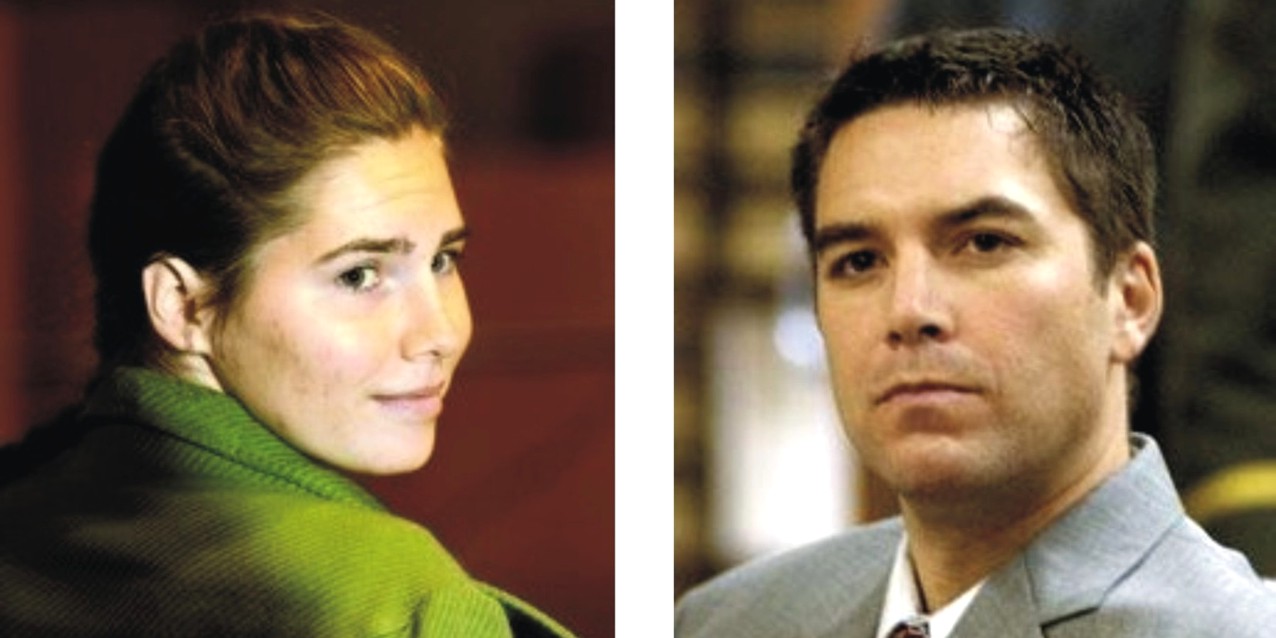
7. Parallels In How The Families Supported Their Children
Not all convicted murderers have a history of mental disturbance or violence. If there were any red flags regarding Knox’s and Peterson’s behavior, one would not know it from the descriptions provided by their families:
- ”˜Lee Peterson said his son never posed a discipline problem, did not rebel as a teenager and was a perfect baby. He was said even to lose golf games because he did not want to hurt the feelings of his opponents. ‘‘He woke up smiling and went to bed smiling.’’ (Scott Peterson’s father of his son, testifying to the jury after Scott’s guilty verdict but before sentencing. New York Times, December 2, 2004)
- “She was an incredible easy-going kid even from a baby. She was so mellow”¦She loved being read-to, she loved books. As she got a little older she always wanted to be outside - building camps, playing soccer. She never watched a lot of TV - she still doesn’t. She was an excellent student.” (Edda Mellas, commenting on Amanda Knox’s character the week of her guilty verdict. The Sun, UK, December 5, 2009)
8. Parallels In Family And Groupie Websites
Peterson and Knox’s families insist on their innocence. There are family and groupie websites for each convicted murderer. They each proclaim innocence for the guilty, make charges of police incompetence, and make requests for money for the defense cause and legal expenses:
- “Scott Peterson Family Mission Statement: “˜This web-site is a combined effort of our family and our support system. We know Scott is innocent and that he has been unjustly convicted. Our pursuit of justice for Laci, Conner and Scott remains steadfast. We want to keep you informed as to the specifics of the case, the appeal, and related topics. We also want you to know how grateful we are for your prayers and support.’ (From: http://scottpetersonappeal.org/)
- “Amanda Knox - A heartfelt thanks for your support. On behalf of Amanda and her family, we want to thank everyone who has contacted FOA to express their concern and to offer help in the wake of an unjust and unsupportable guilty verdict. We are developing a strategy to raise public awareness of this case and help bring about a reversal of the verdicts against both Amanda and Raffaele. Once it is in place, we will welcome all the help we can get, and we will be in touch with you.” (From http://www.friendsofamanda.org/home_eng.htmleartfelt)
Scott Peterson of course has never managed to get online. Amanda Knox of course runs a jubilant, taunting blog which trashes the memory of the victim and harasses her family - a first in global crime history and a foolish move given the current cold, remorseless rejection of her appeal.. Knox’s blog has a following among others also seemingly unable to succeed in normal ways.
9. Parallels In The Verdicts Jurors Delivered: Guilty As Charged
The jurors in each trial fitted together all the pieces of the puzzle: timelines, witness testimony, cell-phone records, forensic evidence, lack of solid alibis, incriminating lies, and odd behavior of the defendants.
They each concluded after lengthy deliberation that the defendants were guilty of murder.
10. And The NON-Parallels In How The US Media Has Reported Both Cases
Of these two cases, not many people have questioned the jury’s decision in the Scott Peterson trial. He has been sentenced to death via lethal injection, and he is currently incarcerated in San Quentin prison in California.
There are no repeated media interviews of Peterson’s mother in tears, insisting on his innocence and his release from prison. There are no angry declarations from Peterson family that the police, prosecution and legal system abused, railroaded and framed Scott Peterson.
If such media coverage were to exist, it would be widely considered in the US to be extremely upsetting and insulting to Laci’s parents and family and to the memory of the victims Laci and Connor.
Peterson’s media coverage, thankfully, has dissipated. He still pursues an appeals process, possibly to be heard next year by the California Supreme Court.
Amanda Knox’s story plays out very differently. After her arrest, her family hired a public relations team that puts forth a determined effort to change Knox’s image of wild child and murderer and to keep her in the news.
They obviously do not consider their repeated loud public outcries for release of their daughter distressing to Meredith’s parents and family, and they don’t perceive their actions as being disrespectful to the victim, Meredith.
Or of course, as many people suspect, perhaps Knox’s relatives do realize it but they simply don’t care.
11. Parallels In Future Legal Prospects
Imprisoned in Italy, Knox has been sentenced to 26 years in prison. She is now appealing that verdict and sentence for the second time after the first appeal was corrupted. In 2012 Scott Petersen’s lawyers filed the automatic appeal against his death sentence to which he is entitled by California law. He may end up serving life.
Knox’s prospects seemed considerably brighter than Peterson’s when the now-annulled Hellmann appeal of 2011 set her free. Now under the worst scenario she loses her new appeal and may end up serving life.

12. Epilogue ““ Master Manipulators
It is curious that the fervent supporters of Amanda Knox do not crusade for the release of Scott Peterson as well. After all, he was convicted on LESS direct evidence, and also in the midst of a maelstrom of publicity. CNN.com had called the Peterson prosecution case so weak and “unimpressive” that they speculated that he could end up with a “Not Guilty” verdict.
But with the exception of his own family, no one has picked up beating the drum to overturn the jury’s conviction of Peterson. Perhaps it is because Peterson doesn’t fit well the damsel in distress role? More likely, it is because the American public trusted the jury’s assessment of the evidence and trial, as they and the American media usually do, and they feel that the jury delivered a just verdict, and justice to Laci and Connor Peterson.
How is it possible that two “regular” people like Knox and Peterson ended up in jail for horrendous murders? Below is a condensed version from an AP article about the type of personality attributed to Scott Peterson:
It is interesting to note that life transitions are tremendous stresses to a psychopath. Psychopaths also wear “false faces” and are master manipulators. They are the ultimate con artists and they are able to fool even those closest to them.
Peterson’s closest friends “never suspected there was a monster inside Scott’s psyche.
Motive still a question in Peterson case
By the Associated Press
Tuesday, December 21, 2004
REDWOOD CITY, Calif. (AP)””Of all the questions surrounding the Laci Peterson murder case, the one that seemed to be running through practically everyone’s mind was this: If Scott Peterson was so unhappy in his marriage, why didn’t he just get a divorce?Experts on the criminal mind say the answer may lie in what lurked beneath Scott Peterson’s charming veneer “”a psychopathic personality.
“When you say you’re going to get a divorce, everyone knows that it’s a long, tedious process. The psychopath wants the short-term solution,” said San Diego forensic psychologist Reid Meloy.
Peterson, 32, was convicted earlier this month of murdering his eight-months-pregnant wife and the fetus she was carrying, and the jury decided he deserves the death penalty.
Criminal psychologists say Peterson appeared to be a master manipulator who lacked the capacity to feel remorse or consider consequences “”some of the same psychopathic characteristics exhibited by serial killers Ted Bundy and John Wayne Gacy.
Psychopaths “tend to con people very well and they wear false faces,” said former FBI profiler Robert Ressler. “They tend to be able to fool everyone from their families to their friends to society, schools, their community.”
At Peterson’s trial, prosecutors portrayed him as a callous liar who continued to carry on an extramarital affair even as police searched for his wife. They said he killed her to escape marriage and impending fatherhood for the freewheeling single life.
Whether Laci’s pregnancy was the catalyst for Peterson’s plan may never be known. But experts said pregnancy can lead to seismic changes within a relationship.
Pregnancy “represents commitment, fatherhood, another dependent, a lifelong bond ... and all of those things are strongly despised by the psychopath,” Meloy said”¦ pregnancy represents a life transition, and there are stresses around that transition.”
Peterson’s case was made all the more perplexing by the lack of signs that the couple’s marriage was in trouble. Although Peterson had cheated on Laci at least three times, according to defense attorney Mark Geragos, he appeared to family and friends to be a doting husband and father-to-be after Laci became pregnant.
Those closest to the couple said they never suspected there was a monster inside.
Heather Richardson, the maid of honor at the Petersons’ wedding, is still hoping for a plausible explanation to emerge. Perhaps, she said, Peterson suffers from a disorder that has yet to be revealed.
“It would be at least comforting. Then I would realize that the person I knew and loved dearly was there. He was that person and the other person, too,” Richardson said. “So at least part of him was not a lie.”
Here is Amanda Knox in her own words talking about masks “” while taking the stand for the final time at her trial in Italy (CNN, Dec. 3, 2009): “They say that I am calm. I am not calm ... I fear to lose myself, to have the mask of the assassin forced upon me.”
This is an update of my post of 24 July 2010
Saturday, November 30, 2013
Note For Strasbourg Court & State Department: Knox Herself Proves She Lies About Her Interrogation
Posted by James Raper

In our previous post Kermit nicely shows how, under the European Court of Human Rights’ own guidelines, Amanda Knox’s “appeal” won’t put her out of reach of the fair and painstaking Italians.
If any of the busy, hard-pressed ECHR investigators do choose to press beyond the ECHR guidelines, they will almost instantly establish that in her voluntary interview on 5 November 2007 Knox was treated with complete fairness.
Also that her false accusation of Patrick (which she never retracted) was entirely of her own doing.
And also that she is not only trying to throw sand into the wheels of Italian justice during an ongoing judicial process (a felony in Italy) but she is trying to welsh out of paying Patrick his damages award of $100,000 (a contempt of the Supreme Court) thus foolishly risking two more charges of aggravated calunnia.
This post derives from a post of mine last May. In another post, we showed that Dr Mignini was not present for the interrogation that night, and Knox maliciously invented an illegal interrogation at risk of a third aggravated calunnia charge.
In fact Dr Mignini met with Amanda Knox only briefly, later, to charge her and to warn she should say no more without a lawyer. He asked her no questions.
I will compare the various accounts of the interrogation to demonstrate that Amanda Knox is indeed lying to the ECHR, just as she did repeatedly in her book this year and also on US and European television.
- There are two main bodies of truth about the interrogation: (1) all of those present at various times on that night and (2) Knox’s own testimony on the witness stand in mid 2009.
- There are two main bodies of lies about the interrogation (1) The Sollecito book and (2) the Knox book, which by the way not only contradict one another but also contradict such other accounts as those of Saul Kassin and John Douglas.
The police had called her boyfriend Raffaele Sollecito in to the station for questioning and Knox had accompanied him because she did not want to be alone. They had already eaten at the house of a friend of Sollecito’s.
Knox’s interrogation was not tape recorded and in that sense we have no truly independent account of what transpired. The police, including the interpreter, gave evidence at her trial, but we do not yet have transcripts for that evidence other than that of the interpreter. There are accounts in books that have been written about the case but these tend to differ in the detail. The police and the interpreter maintain that she was treated well. Apart from the evidence of the interpreter all we have is what Knox says happened, and our sources for this are transcripts of her trial evidence and what she wrote in her book. I shall deal with the evidence of the interpreter towards the end of this article.
I am going to compare what she said at trial with what she wrote in her book but also there was a letter she wrote on the 9th and a recording of a meeting with her mother on the 10th November which are relevant.. What she wrote in her book is fairly extensive and contains much dialogue. She has a prodigious memory for detail now which was almost entirely lacking before. I am going to tell you to treat what she says in her book with extreme caution because she has already been found out for, well let us say, her creative writing if not outright distortion of facts. I shall paraphrase rather than quote most of it but a few direct quotes are necessary.
Knox arrived with Sollecito at the police station at about 10.30 pm (according to John Follain). The police started to question Sollecito at 10.40 pm (Follain).
In her book Knox describes being taken from the waiting area to a formal interview room in which she had already spent some time earlier. It is unclear when that formal questioning began. Probably getting on for about 11.30pm because she also refers to some questions being asked of her in the waiting room following which she did some stretches and splits. She then describes how she was questioned about the events over a period from about the time she and Sollecito left the cottage to about 9 pm on the 1st November.
Possibly there was a short break. She describes being exhausted and confused. The interpreter, Knox says, arrived at about 12.30 am. Until then she had been conversing with the police in Italian.
Almost immediately on the questioning resuming -
“Monica Napoleoni, who had been so abrupt with me about the poop and the mop at the villa, opened the door. “Raffaele says you left his apartment on Thursday night,” she said almost gleefully. “He says that you asked him to lie for you. He’s taken away your alibi.””
Knox describes how she was dumfounded and devastated by this news. She cannot believe that he would say that when they had been together all night. She feels all her reserves of energy draining away. Then -
“Where did you go? Who did you text?” Ficarra asked, sneering at me.
“I don’t remember texting anyone.”
They grabbed my cell phone up off the desk and scrolled quickly through its history.
“You need to stop lying. You texted Patrick. Who’s Patrick?”
“My boss at Le Chic.”
Stop right there.
How were the police able to name the recipient of the text? The text Patrick had sent her had already been deleted from Knox’s mobile phone by Knox herself and Knox hasn’t yet named Patrick. In fact she couldn’t remember texting anyone.
It is of course probable that the police already had a log of her calls and possibly had already traced and identified the owner of the receiving number for her text, though the last step would have been fast work.
In her trial testimony Knox did a lot of “the police suggested this and suggestd that” though it is never crystal clear whether she is accusing the police of having suggested his name. But she is doing it here in her book and of course the Knox groupies have always maintained that it was the police who suggested his name to her.
The following extract from her trial testimony should clear things up. GCM is Judge Giancarlo Massei.
GCM: In this message, was there the name of the person it was meant for?
AK: No, it was the message I wrote to my boss. The one that said “Va bene. Ci vediamo piu tardi. Buona serata.”
GCM: But it could have been a message to anyone. Could you see from the message to whom it was written?
AK: Actually, I don’t know if that information is in the telephone”¦”¦”¦”¦”¦”¦”¦..
GCM : But they didn’t literally say it was him!
AK : No. They didn’t say it was him, but they said “We know who it is, we know who it is. You were with him, you met him.”
GCM : Now what happened next? You, confronted with the message, gave the name of Patrick. What did you say?”
AK : Well, first I started to cry…....
And having implied that it was the police who suggested Patrick’s name to her, she adds”¦.. that quote again -
“You need to stop lying. You texted Patrick. Who’s Patrick?”
“My boss at Le Chic.”
Here she is telling the Perugian cops straight out exactly to whom the text was sent. “My boss at Le Chic”.
But that does not quite gel with her trial testimony -
And they told me that I knew, and that I didn’t want to tell. And that I didn’t want to tell because I didn’t remember or because I was a stupid liar. Then they kept on about this message, that they were literally shoving in my face saying “Look what a stupid liar you are, you don’t even remember this!”
At first, I didn’t even remember writing that message. But there was this interpreter next to me who kept saying “Maybe you don’t remember, maybe you don’t remember, but try,” and other people were saying “Try, try, try to remember that you met someone, and I was there hearing “Remember, remember, remember…..
Doesn’t the above quote make it clear that the police were having considerable trouble getting Knox to tell them to whom her text message was sent? It would also explain their growing frustration with her.
But perhaps the above quote relates not to whom the text was sent but, that having been ascertained, whether Knox met up with that person later? Knox has a habit of conflating the two issues. However there is also the following quote from her trial testimony -
Well there were lots of people who were asking me questions, but the person who had started talking with me was a policewoman with long hair, chestnut brown hair, but I don’t know her. Then in the circle of people who were around me, certain people asked me questions, for example there was a man holding my telephone, and who was literally shoving the telephone into my face, shouting “Look at this telephone! Who is this? Who did you want to meet?”
Then there were others, for instance this woman who was leading, was the same person who at one point was standing behind me, because they kept moving, they were really surrounding me and on top of me. I was on a chair, then the interpreter was also sitting on a chair, and everyone else was standing around me, so I didn’t see who gave me the first blow because it was someone behind me, but then I turned around and saw that woman and she gave me another blow to the head.
The woman with the long hair, chestnut brown hair, Knox identifies in her book as Ficarra. Ficarra is the policewoman who started the questioning particularly, as Knox has confirmed, about the texted message. “Look at this telephone! Who is this? Who did you want to meet?” Again, surely this is to get Knox to identify the recipient of the text, not about whether she met up with him?
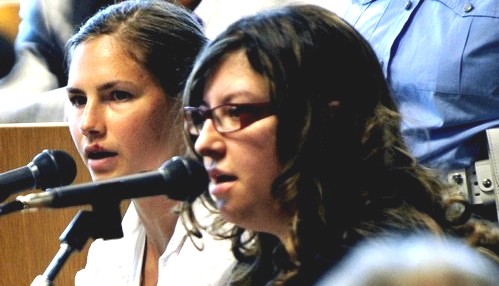
In the book though, it is all different.
In the book, the police having told her that the text is to someone called Patrick, Knox is a model of co-operation as, having already told them that he is her boss at Le Chic, she then gives a description of him and answers their questions as to whether he knew Meredith, whether he liked her etc. No reluctance to co-operate, no memory difficulties here.
Notwithstanding this, her book says the questions and insinuations keep raining down on her. The police insist that she had left Sollecito’s to meet up with - and again the police name him - Patrick.
“Who did you meet up with? Who are you protecting? Why are you lying? Who’s this person? Who’s Patrick?”
Remember again, according to her trial testimony the police did not mention Patrick’s name and Knox still hasn’t mentioned his name. But wait, she does in the next line -
“I said “Patrick is my boss.””
So now, at any rate, the police have a positive ID from Knox regarding the text message and something to work with. Patrick - boss - Le Chic.
Knox then refers to the differing interpretations as to what “See you later” meant and denies that she had ever met up with Patrick that evening. She recalls the interpreter suggesting that she was traumatized and suffering from amnesia.
The police continue to try to draw an admission from Knox that she had met up with Patrick that evening - which again she repeatedly denies. And why shouldn’t she? After all, she denies that she’s suffering from amnesia, or that there is a problem with her memory. The only problem is that Sollecito had said she had gone out but that does not mean she had met with Patrick.
Knox then writes, oddly, as it is completely out of sequence considering the above -
“They pushed my cell phone, with the message to Patrick, in my face and screamed,
“You’re lying. You sent a message to Patrick. Who’s Patrick?”
That’s when Ficarra slapped me on my head.”
A couple of blows (more like cuffs) to the head (denied by the police) is mentioned in her trial testimony but more likely, if this incident ever happened, it would have been earlier when she was struggling to remember the text and to whom it had been sent. Indeed that’s clear from the context of the above quotes.
And this, from her trial testimony -
Remember, remember, remember, and then there was this person behind me who—it’s not that she actually really physically hurt me, but she frightened me.”
In the CNN TV interview with Chris Cuomo, Knox was asked if there was anything she regretted.
Knox replied that she regretted the way this interrogation had gone, that she wished she had been aware of her rights and had stood up to the police questioning better.
Well actually, according to the account in her book, she appears to have stood up to the police questioning with a marked degree of resilience and self- certainty, and with no amnesia. There is little of her trademark “being confused”.
So why the sudden collapse? And it was a sudden collapse.
Given the trial and book accounts Knox would have us think that she was frightened, that it was due to exhaustion and the persistent and bullying tone of the questioning, mixed with threats that she would spend time in prison for failing to co-operate. She also states that -
(a) she was having a bad period and was not being allowed to attend to this, and
(b) the police told her that they had “hard evidence” that she was involved in the murder.
Knox has given us a number of accounts as to what was actually happening when this occurred.
In a letter she wrote on the 9th November she says that suddenly all the police officers left the room but one, who told her she was in serious trouble and that she should name the murderer. At this point Knox says that she asked to see the texted message again and then an image of Patrick came to mind. All she could think about was Patrick and so she named him (as the murderer).
During a recorded meeting with her mother in Capanne Prison on the 10th November she relates essentially the same story.
In her book there is sort of the same story but significantly without mention of the other officers having left the room nor mention of her having asked to see the texted message again.
If the first two accounts are correct then at least the sense of oppression from the room being crowded and questions being fired at her had lifted.
Then this is from her book -
In that instant, I snapped. I truly thought I remembered having met somebody. I didn’t understand what was happening to me. I didn’t understand that I was about to implicate the wrong person. I didn’t understand what was at stake. I didn’t think I was making it up. My mind put together incoherent images. The image that came to me was Patrick’s face. I gasped. I said his name. “Patrick””it’s Patrick.
It’s her account, of course, but this “Patrick - It’s Patrick” makes no sense at this stage of it unless it’s an admission not just that she had met up with Patrick but that he was at the cottage and involved in Meredith’s death.
And this is from her trial testimony -
GCM : Now what happened next? You, confronted with the message, gave the name of Patrick. What did you say?
AK : Well, first I started to cry. And all the policemen, together, started saying to me, you have to tell us why, what happened? They wanted all these details that I couldn’t tell them, because in the end, what happened was this: when I said the name of Patrick I suddenly started imagining a kind of scene, but always using this idea: images that didn’t agree, that maybe could give some kind of explanation of the situation.
There is a clear difference between these two quotes.
The one from her book suggests that she was trying hard but that the police had virtually brought her to the verge of a mental breakdown.
Her trial testimony says something else; that a scene and an idea was forming in her mind brought on by her naming of Patrick.
In her book she states that a statement, typed up in Italian, was shoved under her nose and she was told to sign it. The statement was timed at 1.45 am. The statement was not long but would probably have taken about twenty minutes to prepare and type.
The statement according to Knox -
... I met Patrick immediately at the basketball court in Piazza Grimana and we went to the house together. I do not remember if Meredith was there or came shortly afterward. I have a hard time remembering those moments but Patrick had sex with Meredith, with whom he was infatuated, but I cannot remember clearly whether he threatened Meredith first. I remember confusedly that he killed her.
The fact that the statement was in Italian is not important. Knox could read Italian perfectly well. However she does insinuate in the book that the details in the statement were suggested to her and that she didn’t bother to read the statement before signing.
Apart from what has been mentioned above, there are some other points and inferences to be drawn from the above analysis.
- 1. Knox’s account destroys one of Sollecito’s main tenets in his book Honour Bound. Sollecito maintains that he did nothing to damage Knox’s alibi until he signed a statement, forced on him at 3:30 am and containing the damaging admission that Knox had gone out. But Knox makes it clear that she had heard from the Head of the Murder Squad that he had made that damaging admission, at or shortly after 12.30 am. Or is Knox is accusing Napoleoni of a bare-faced lie?
2. It is valid to ask why Knox would not want to remember to whom the text had been sent. Who can see into her mind? Perhaps Knox realized that discussion of it would confirm that if she had indeed gone out then it was not to Le Chic, where she was not required. However even if she thought that could put her in the frame it’s not what an innocent person would be too worried about. Perhaps she did just have difficulty remembering?
3. If there was no fuss and she did remember and tell the police that the text was to Patrick, and the questioning then moved on to whether she met up with Patrick later that evening, what was the problem with that? She knew the fact that she hadn’t met up with him could be verified by Patrick. She could have said that and stuck to it. The next move for the police would have been to question Patrick. They would not have had grounds to arrest him.
4. Knox stated in her memorial, and re-iterates it in her book, that during her interrogation the police told her that they had hard evidence that she was involved in Meredith’s murder. She does not expand on what this evidence is, perhaps because the police did not actually tell her. However, wasn’t she the least bit curious, particularly if she was innocent? What was she thinking it might be?
5. I can sympathise with any interviewee suffering a bad period, if that’s true. However the really testy period of the interview/interrogation starts with the arrival of the interpreter, notification of Sollecito’s withdrawal of her alibi and the questioning with regard to the text to Patrick, all occurring at around 12.30 am. There has to be some critical point when she concedes, whether to the police or in her own mind, that she’d met “Patrick”, after which there was the questioning as to what had happened next. Say that additional questioning took 20 minutes. Then there would be a break whilst the statement is prepared and typed up. So the difficult period for Knox, from about 12.30 am to that critical point, looks more like about 35 to, at the outside, 50 minutes.
6. Even if, for that period, it is true that she was subjected to repeated and bullying questions, and threats, then she held up remarkably well as I have noted from her own account. It does not explain any form of mental breakdown, let alone implicating Patrick in murder. In particular, if Knox’s letter of the 9th and the recording of her meeting with her mother on the 10th are to believed, that alleged barrage of questions had stopped when she implicated Patrick. An explanation, for what it’s worth, might be that she had simply ceased to care any longer despite the consequences. But why?
7. A better and more credible explanation is that an idea had indeed formed suddenly in her mind. She would use the revelation about the text to Patrick and the consequent police line of questioning to bring the questioning to an end and divert suspicion from her true involvement in the murder of Meredith Kercher. She envisaged that she would be seen by the police as a helpless witness/victim, not a suspect in a murder investigation. As indeed was the case initially. She expected, I am sure, to be released, so that she could get Sollecito’s story straight once again. If that had happened there would of course remain the problem of her having involved Patrick, but I dare say she thought that she could simply smooth that over - that it would not be a big deal once he had confirmed that there had been no meeting and that he had not been at the cottage, as the evidence was bound to confirm.
At the beginning I said that we also have a transcript now of the evidence of the interpreter, Anna Donnino. I will summarise the main points from her evidence but it will be apparent immediately that she contradicts much of what Knox and her supporters claim to have happened.
Donnino told the court that she had 22 years experience working as a translator for the police in Perugia. She was at home when she received a call from the police that her services were required and she arrived at the police station at just before 12.30 am, just as Knox said. She found Knox with Inspector Ficarra. There was also another police officer there whose first name was Ivano. At some stage Ficarra left the room and then returned and there was also another officer by the name of Zugarina who came in. Donnino remained with Knox at all times
The following points emerge from her testimony :-
- 1. Three police officers do not amount to the “lots of people” referred to in Knox’s trial testimony, let alone the dozens and the “tag teams” of which her supporters speak.
2. She makes no mention of Napoleoni and denied that anyone had entered the room to state that Sollecito had broken Knox’s alibi. (This is not to exclude that this may have happened before Donnino arrived)
3. She states that Knox was perfectly calm but there came a point when Knox was being asked how come she had not gone to work that she was shown her own text message (to Patrick). Knox had an emotional shock, put her hands to her ears and started rolling her head and saying “It’s him! It’s him! It’s him!”
4. She denied that Knox had been maltreated or that she had been hit at all or called a liar.
5. She stated that the officer called Ivano had been particularly comforting to Knox, holding her hand occasionally.
6. She stated that prior to the 1.45 am statement being presented to Knox she was asked if she wanted a lawyer but Knox said no.
7. She stated that she had read the statement over to Knox in english and Knox herself had checked the italian original having asked for clarification of specific wording.
7. She confirmed that that she had told Knox about an accident which she’d had (a leg fracture) and that she had suffered amnesia about the accident itself. She had thought Knox was suffering something similar. She had also spoken to Knox about her own daughters because she thought it was necessary to establish a rapport and trust between the two of them.
The account in Knox’s book is in some ways quite compelling but only if it is not compared against her trial testimony, let alone the Interpreter’s testimony: that is, up to the point when she implicates Patrick in murder. At that point no amount of whitewash works. The Italian Supreme Court also thought so, upholding Knox’s calunnia conviction, with the addition of aggravating circumstances.
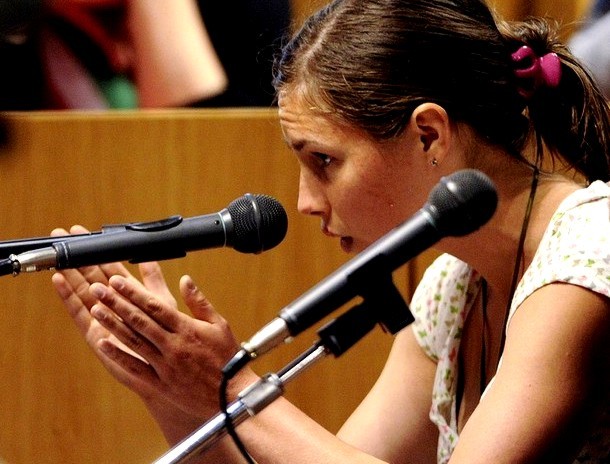
Wednesday, November 27, 2013
Amanda Knox Lies Again To Get Herself Into Another European Court “But Really, Judge, Its Only PR”
Posted by Kermit
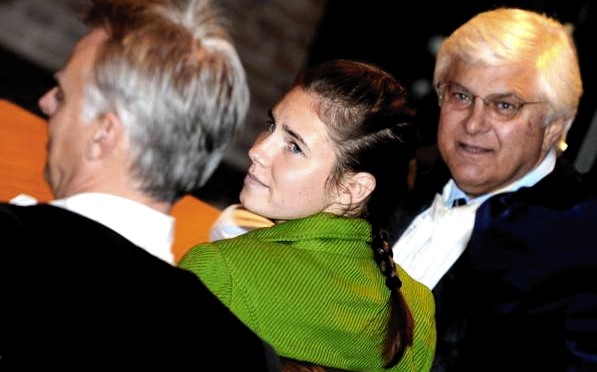
[Amanda Knox’s lawyer Luciano Ghirga (right): “Amanda wasn’t hit, we made no complaint”]
Introduction
This is the first of two posts on Knox’s claim to have sent an appeal to the Strasbourg-based European Court of Human Rights (ECHR).
Last Monday the main event that followers of the Meredith Kercher murder case were awaiting was the closing argument by Prosecutor Alessandro Crini in Amanda Knox’s and Raffaele Sollecito’s appeal trial.
Dr Crini’s structuring of the prosecution’s case in 16 points demolished the defendants’ efforts to present the volume of evidence against them as an incredible, long series of mistakes, coincidences and misunderstandings.
It seems, however, that Amanda Knox and her people didn’t want the public to be too fascinated by Dr Crini’s devastating argument. They really wanted them to be distracted by what can only be seen as an ill-judged public relations move, breaking yet more laws along the way.
Knox attempted to blow smoke over the prosecution’s arguments by grandly announcing “today, my lawyers filed an appeal of my slander[sic] conviction with the European Court of Human Rights.” That explanation of her PR ploy calls for a close review of her eligibility (here) and her so-called proof (next post).
Knox’s eligibility or otherwise
The European Court of Human Rights, is a supranational European tribunal dedicated to ““ as its name suggests - human rights.
It is not dedicated to criminal or civil proceedings on murder, sexual assault, theft, simulation of a crime, or any of the other charges that Knox faces.
In fact, to avoid the many unnecessary or spurious applications which hamper real cases getting attended to, the ECHR provides a number of online resources on who may apply and how and why.
One of the first issues that its advice underlines is that it is not a glorified appeals court:
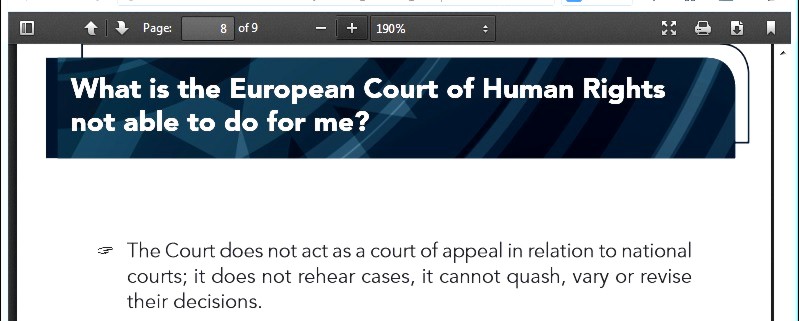
It is strange then, that Amanda Knox claims that her lawyers have “appealed” her case to the ECHR.
Either Knox’s legal advisors are just ignorant (which ones? The Italian professionals, or the American media hacks?) or this is simply a last-ditch Hail Mary action as an extradition request moves inexorably closer.
If the ECHR makes clear that it isn’t a court of appeal, there shouldn’t be any direct correlation between the Supreme Court confirming her as a convicted criminal and her application to the ECHR.
If that is in fact the basis of their application, it will not go far before rejection. In fact, the vast majority (more than 95%) of applications get rejected:
“For a number of years now, and owing to a variety of factors, the Court has been submerged by individual applications (over 130,000 were pending as at 31 August 2010). The overwhelming majority of these applications (more than 95%) are, however, rejected without being examined on the merits for failure to satisfy one of the admissibility criteria laid down by the Convention.
This situation is frustrating on two counts.
Firstly, as the Court is required to respond to each application, it is prevented from dealing within reasonable time-limits with those cases which warrant examination on the merits, without the public deriving any real benefit.
Secondly, tens of thousands of applicants inevitably have their claims rejected, often after years of waiting.”
It would be a outrageous if other, real human rights cases were delayed due to a Public Relations ruse as part of an extra-judicial strategy to undermine a request for Knox’s extradition.
Other ECHR on-line resources help potential applicants decide if they be eligible to be heard at the Court.
Below, a work-flow chart presents the main steps, including various “Admissibility Criteria”:
A first admissibility criterion
The first Admissibility criterion is that an applicant has exhausted “domestic remedies” in pursuing the recognition and correction of the human rights he or she feels have been abused.
Knox in her application to the ECHR directly relates the Italian Supreme Court final confirmation of her “calunnia” sentence (three years for obstruction of justice for framing her kindly boss Patrick Lumumba as the murderer of Meredith Kercher, thereby throwing off the course of the investigation) to her application to the ECHR.
But what were the supposed human rights abuses suffered? What did she do to remedy them?
The first requirement of exhausting “domestic remedies” means that the rights abuses that Knox alleges she has suffered have been pursued in Italy, and that all possible instances of reclamation in Italy have been visited.
However, as far as the public knows, Knox has not even placed a formal complaint concerning supposed civil rights abuse. Certainly her own Italian lawyers have said they havent.
The US and Italian publics would be interested in seeing her specific claims to the ECHR and whether there is any registration of such claims or complaints with the Italian police or other administrative or NGO offices.
Knox’s needling stepfather, Chris Mellas, stated in April 2008 on a precursor to the PMF discussion forum that a complaint had been filed concerning Amanda being hit during questioning.
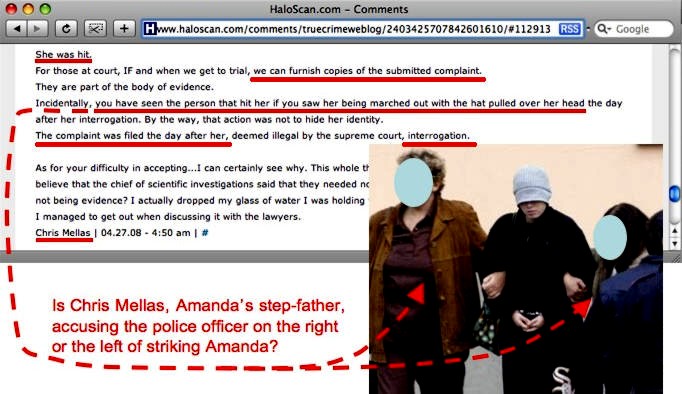
[Click for larger version]
However, nothing more has ever been heard of this complaint, which definitely would have been a starting point for pursuing domestic Italian remedies to the claimed rights abuse.
Since it appears zero rights abuses have been pursued in Italy, and the date of Knox’s application to the ECHR is in effect unrelated to her “calunnia” sentence confirmed by the Supreme Court, the six month limit beyond national remedies related to the rights abuse for applying to the ECHR is irrelevant here.
It should be noted that when Prosecutor Crini asked this week for an addition to Knox’s confirmed sentence for “calunnia”, adding another year to the three years already served by the convicted criminal, this is not a reopening of the “calunnia” case or an example of “double jeopardy”, but rather the reassessment on appeal of a separate, pending issue related to the basic calunnia charge: whether it should include an additional year of sentence for being aggravated.
Since this aggravation addition to the charge is awaiting determination, and follows from instructions of the Italian Supreme Court (and could result in an additional year in prison), it is not part of the prior, confirmed sentence.
A second admissibility criterion
Now just in case Knox or her lawyers would like to allege any perceived human rights abuse whatsoever in their ECHR application, the Strasbourg court insists on the reclamation in question being directly related to one of the sections of the European Convention on Human Rights
I’ve gone through it and I see chapters related to illegal detention (detention permitted only following arrest) and torture, but nothing related to getting cuffed on the back of your head.
If such an event ever occurred, it shouldn’t have, but quite likely one of the other authorities or rights bodies listed by the ECHR may be better equipped to deal with it.
This is a second Admissibility Criterion that filters out many applications: one can’t simply run to the ECHR saying “my rights have been abused” ““ the issue at hand must be directly related to the European Convention on Human Rights.
I seriously doubt the “hitting” event ever occurred because Knox’s own Italian lawyer Luciano Ghirga denied it, stating to the Press on 21 October 2008:
Amanda wasn’t hit. There were pressures fom the police, sure, but we never said she was hit.
As our next post here on this same subject will show, even Knox herself admitted she was treated well.
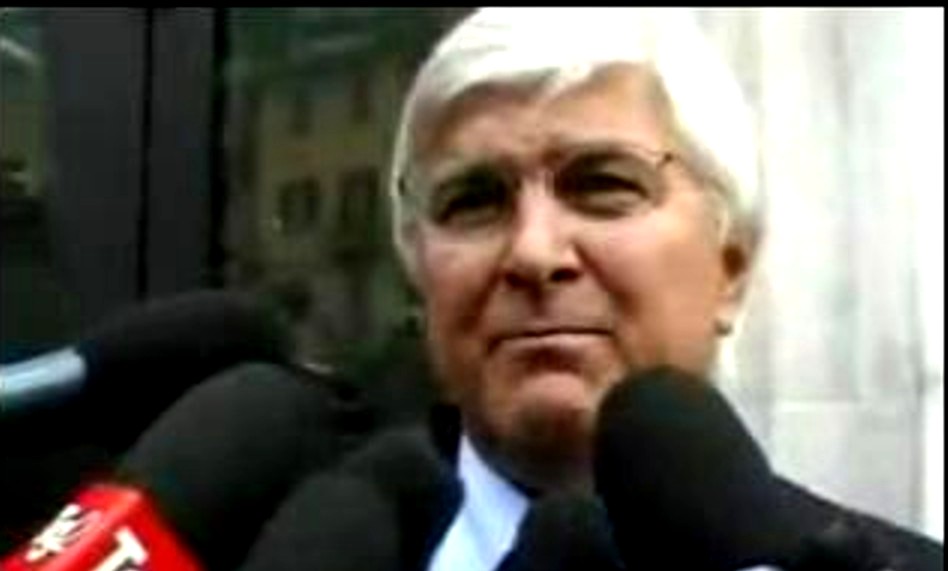
[Above: Amanda Knox’s Italian courtroom lawyer stating to the Press in 2008 that she had not been hit.]
If Knox hasn’t even tried to remedy being allegedly hit in Italy by suing or making formal complaints, nevertheless the Italian police certainly have acted upon such suggestions.
A number of legal processes are under way against Knox and her family members for slander and calunnia. Knox might face two more charges of aggravated calunnia. Why do I doubt that Knox has even mentioned those other legal processes in her application to the ECHR?
Those charges would of course have to be taken care of (as part of “exhausting domestic remedies”) before the ECHR would be able to consider her application, assuming it surmounted all of its other shortcomings to get to the ECHR judges’ hands.
A third admissibility criterion
Another Admissibility Criteria is the “Significant Disadvantage” filter. If an alleged rights abuse is minimal ““ compared to the very serious issues that the ECHR was created to consider ““ the application will go no further.
The only violent description of Knox’s alleged beating was given by her stepfather, Chris Mellas: “She was interrogated, and hit, and threatened,” he typed. “Tortured. Physically and mentally”.
However, there was never any medical or forensic notification of such “torture” before or after her incarceration in Capanne Prison.
Rather, Knox spent her time in prison receiving regular visits from a lovelorn Italian politician who befriended her, and participating in prison musical and theatrical activities.
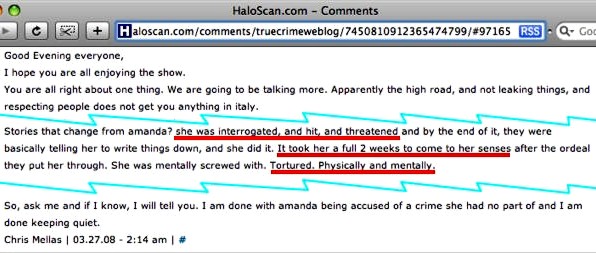
[Click for larger version]
In underlying the “significant disadvantage” requirement, the ECHR states in its examples of rejected claims, that it can’t be distracted by the French driver who lost a point on his driver’s licence, or the Romanian who claims 90 euros from the State, when the Court has real and serious Human Rights cases to deal with such as:
- El-Masri v. the former Yugoslav Republic of Macedonia (Article 3 of European Convention on Human Rights: Torture and inhuman and degrading treatment during and following applicant’s extraordinary rendition to CIA)
- Hirsii Jamaa and others v. Italy (Article 4 of Protocol No. 4: Return of migrants intercepted on the high seas to country of departure)
It’s almost certain that Knox has not pursued on an Italian level any remedies to her alleged human rights abuse (whatever it was), nor is there any evidence that the investigation into Meredith Kercher’s murder and the subsequent trials of Knox, Rudy Guede and Raffaele Sollecito were affected in their outcome by the rights abuse.
This is especially the case if the limit of Knox’s human rights suffering is that described by a talky ex-FBI helicopter pilot turned ex-college security guy turned Amanda Knox groupie, Steve Moore.
Moore describes the “frightful” circumstances of Knox’s witness questioning on the night of 5 November 2007 for the couple of hours (perhaps even somewhat less) that it lasted:
No food, no coffee, no bathroom breaks ““ nothing.
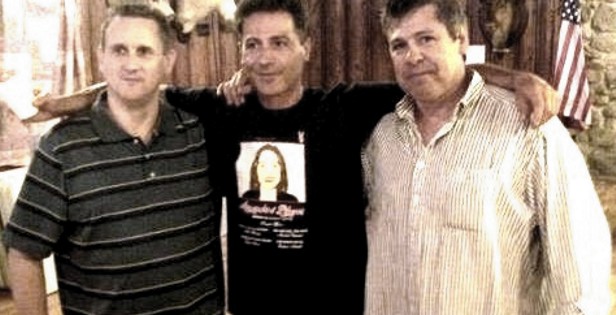
Above is ex-college security man Steve Moore, right, together with PR flunkie Bruce Fischer, left, both flanking “Frank Sfarzo”, a Knox-Mellas family friend.
Francesco Sforza is currently a fugitive from the Seattle courts on two counts of Assault-Domestic Violence, who continues to support Amanda in ongoing Internet blog posts, from wherever he may be.
See below. Click for larger. In purple, my corrections to Knox’s “what-I-want-the-World-to-believe” post about applying to the ECHR.
In conclusion
Between the manifest doubtfulness of the acceptability of Knox’s application to the European Court of Human Rights, on one hand, and the falsehoods and half-truths in her announcement, on the other, why do I get the feeling that the only reason and hope she and her team have in announcing the application (whether really filed or not) is to distract the attention of the followers of her appeal trial from the prosecution’s weighty arguments?
This will have little if any effect on the wheels of Italian Justice, and probably even less on a State Department more concerned with maintaining good relations with European allies while diplomatic challenges occur in the Middle East and Asia, than with a lobby plan to prevent Knox’s extradition.
[Below: The European Court of Human Rights in Strasbourg France]
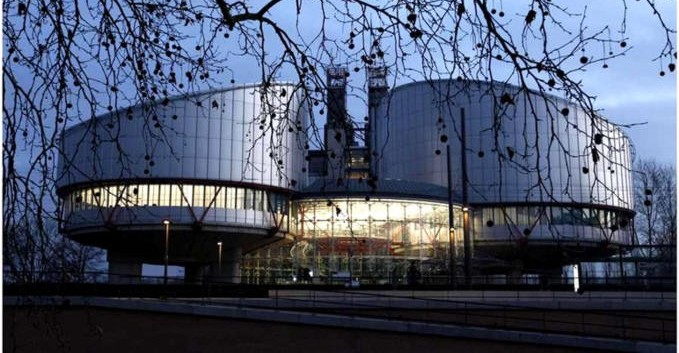
Wednesday, October 16, 2013
Amanda Knox Risks Penalties For Felony Claims No Different From What Already Cost Her 3 Years
Posted by Peter Quennell
Here is the Amanda Knox Skype interview transcribed for us from the video in Italy. The interviewer is mushy (too much so) and really distorts key facts, and so does Knox. You can see her claim she was framed. Her denials are without substance and seem mechanical and half-hearted. Time for Plan B?
A common question on forums today is “Can Amanda Knox make these very public false charges and suffer no penalty?”
The short answer seems to be no. First, she has made the possibility of early arrest to put a stop to that more likely. If Judge Nencini saw the Porta a Porta TV program last night he will be giving thought to his options. Negotiating on arrest is ruled out by law
And second, for the dozens of false charges in her book and numerous TV and print interviews, she could be facing some more time in prison quite regardless of how the Nencini appeal works out for her. And a guilty verdict there could cost her 30 years and damages.
One thing nobody thought to point out on the rudderless and badly informed Porta a Porta show last night is that Knox is already being investigated for identical false charges.
EVERYTHING she says now is added to that “treasure trove” of actionable accusations. Penalties for these felonies vary; but if one has a prior conviction, some prison time is almost inevitable.
Sorely missing from the Porta a Porta panel last night was their usual magistrate, Simonetta Matone, who has always raised tough questions. Was there a deal not to have her present on what was a distinctly tilted panel?
Knox seems to have committed at least one felony in her book with the pages-long accusation that the investigating prosecutor Dr Mignini was not only present at her interrogation (he wasn’t) but leaning on her to frame Patrick (not being there, of course he didn’t.).
Why didn’t anyone on Porta a Porta introduce that false accusation last night, which was widely reported in the Italian media after her book came out? Or mention her lamp behind Meredith’s door lacking fingerprints, or the mixed-blood traces outside Meredith’s door which seem to strongly relate to what the Carabinieri labs in Rome are now investigating?
Even the defense lawyers are seeing culpability growing, as they are given full credit for helping to write the defamatory books. They all made themselves scarce last night, did anyone notice that?
Do you ever wonder why Knox or Sollecito don’t push their own lawyers forward to take on this challenge?
Below: Pro-prosecution Magistrate Simonetta Matone suspiciously absent last night]
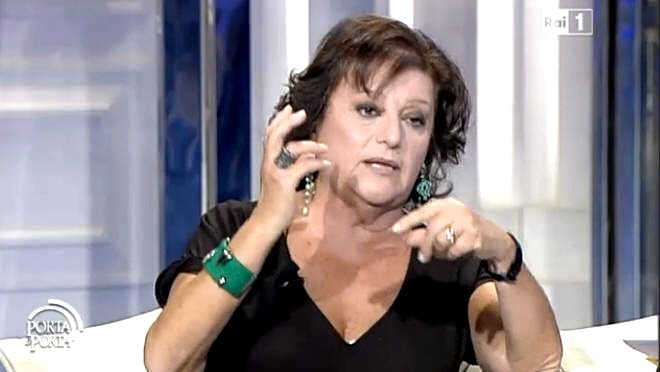
Sunday, October 06, 2013
Dr Mignini Pushes Back Against His Demonizers Trying To Ascribe Non-Existant “Satanic Theory”
Posted by Peter Quennell
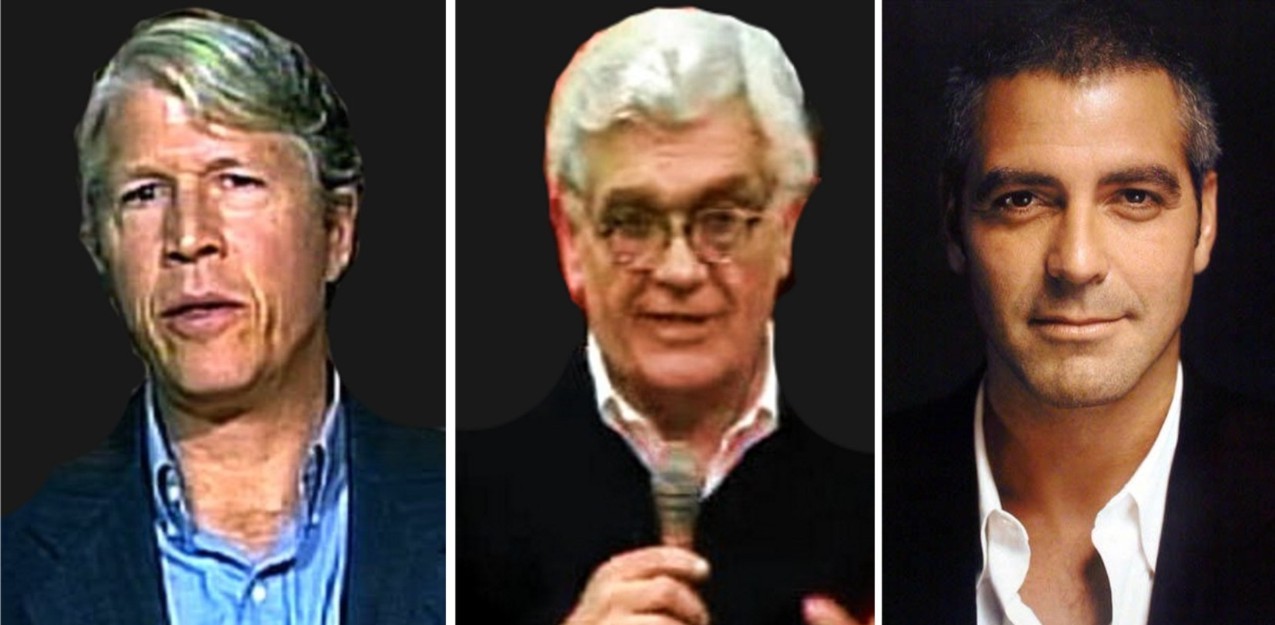
[Preston left, Spezi center, and George Clooney who is at legal risk for his option on their defamatory book]
1. Dr Mignini’s Published Statement
To the editor of Florence Corriere
Dear Director,
I am Giuliano Mignini, the magistrate who performed the investigation and trials of first instance and appeal in Perugia against the people accused of the murder of Meredith Kercher, as well as the investigation into the death of Francesco Narducci linked to the one performed by the Florence Prosecution Office in relation to the masterminds of the “Monster of Florence” murders.
I saw reported the interview that the journalist Mario Spezi ““ a person accused in the Narducci case ““ did with Amanda Knox, a main defendant in the appeal trial that will start today ““ published in the Corriere Fiorentino on Sep. 29.
In two recent cases the Court of Cassation has annulled verdicts, which acquitted Knox and Sollecito, and which decided [by Judge Micheli] a dropping of charge against Spezi (the parts regarding “˜lack of certainty about malice’ were annulled too).Therefore I don’t need to add anything further on that point. Instead, I need to point out the falsehood of an assertion which Mr. Spezi makes at the beginning of his article, as he tries to explain the reason for a link which, in his opinion, allegedly exists between the two cases, the one related to the Monster murders and Narducci’s death, and the one about the Kercher murder.
Mr. Spezi’s text says: “”¦ a strangely similar background, for two different cases, behind which the magistrate thought he could see satanic orgies on the occasion of Halloween for Amanda, and ritual blood sacrifices as a worship to the Devil in the Monster of Florence case”¦”.
This is an assertion that Mr. Spezi and crime-fiction author Douglas Preston have been repeating for years, but does not find the smallest confirmation in the documentation of the two trials, nor in the scenario put forward by the prosecution in which the Meredith murder (which didn’t happen on Halloween but on the subsequent night) was the consequence of a sex hazing to which Meredith herself did not intend to take part, and, above all, it was the consequence of a climate of hostility which built up progressively between the Coulsdon girl and Amanda because of their different habits, and because of Meredith’s suspicion about alleged money thefts by Knox.
Furthermore the object of the proceedings in the Narducci case is the scenario about the murder of the same Narducci and the attempt, by the doctor’s father and brother, to conceal the cause of his violent death, and this included the background within which the event ““ which was a homicide in my opinion and in the opinion of my technical consultant, coroner Prof. Giovanni Pierucci of the University of Pavia ““ had developed and taken place.
I had already denied several time assertions of such kind, but Mr. Spezi and Mr. Preston, and some people connected to them, go on repeating a lie, apparently hoping that it will become true by repeating it.
Another astonishing fact is that, despite that I was the prosecutor in the Kercher trial together with my colleague Manuela Comodi and then subsequently with my colleague Giancarlo Costagliola [at annulled apeal], and despite that I limited myself to formulating judicial requests which were all agreed to by a multitude of judges and confirmed by the Supreme Court, I am still considered as the only one responsible for an accusation against Ms. Knox and Mr. Sollecito, by twisting its content in various ways.
In the Narducci case, in the same way, I simply limited myself to performing the investigation and requesting the remands to trial, and the trial will have to start again now because the Supreme Court has annulled the dropping of charges [by Judge Micheli] and sent back the trial to another preliminary judge in Perugia.
The purpose ““ quite overt ““ of such endlessly repeated lies, is to defame the investigator, picturing him as a magistrate who is following alleged personal obsessions rather than sticking at facts, as instead he is.
The hope that such conscious misrepresentation of reality could bring advantage to the defences (foremost that of Spezi himself) is consistent with a bad habit which has all along flourished in Italy but is now also copied abroad.
Therefore I ask you to please publish my rectification against false and seriously defamatory information.
Kind regards
Giuliano Mignini
2. Context: The Mafia Playbook Adherents
As we have often d previously, the mafia and their handmaidens strive constantly to bring the Italian justice system down a peg or two.
When not using dynamite, as they often did in the past, they especially favor the weapon of character assassination of witnesses, judges prosecutors and police.
The vilification campaign being run in the United States by David Marriott, Chris Mellas, Doug Preston, Bruce Fischer, Steve Moore, Michelle Moore, Nigel Scott, and David Anderson (and from Italy by Frank Sforza) seems to be right out of the mafia playbook, whether all of them know it or not.
How the mafia have been using the public relations campaign to their own advantage seems set to emerge further in at least five of the associated trials coming down the pike: those of Luciano Aviello, Frank Sforza, Mario Spezi, Raffaele Sollecito (his book trial) and Amanda Knox (her book trial).
And now Mario Spezi, obviously a real glutton for punishment, once again piles on. Spezi has had incessant run-ins with the Italian law - and now he seems to have entered some kind of self-immolation end-game.
With Doug Preston, Spezi published several editions of their Monster of Florence scenario. These are widely discredited in Italy, not least because they are such obvious attempts to apply lipstick to a pig (half of the text is about an obviously red-handed and very very scared Preston trying to prove he did not actually melt down under interrogation for his probable felony interference in a case.)
Spezi has been charged with interfering with and hampering both the Monster of Florence investigations and the related investigation (which involved Dr Mignini) into the Narducci drowning - a clear murder (the body was found bound and another substituted) though a nefarious group worked very hard to deny that. (They were all charged as well, and the Supreme Court has recently confirmed the correctness of that.)
In recent weeks the Supreme Court has given a firm order for both prosecutions against Spezi to go ahead. How Spezi stays out of prison if he is found guilty is anyone’s guess. Doug Preston came up with a calamity of an explanation for the arrest of Frank Sforza for domestic violence, but presumably his assistance wont be sought this time around.
So in face of impending prison Spezi really watches his tongue, right?
No, in fact in a move bizarre even by his own standards, Spezi on 29 September published a surreal “interview” with Amanda Knox in Florence Corriere. It once again repeats the felony claim that the prosecution charged Knox and Sollecito in the first place based only on some “satanic theory”.
The Perugia prosecution has never never NEVER claimed that. The Florence prosecutor has already moved into felony-investigation mode (this could cost Spezi more years in prison) and on 3 October Florence Corriere published this correction below by the defamed prosecution (translation is by Yummi).
This unequivocal statement (far from the first but the most prominent) has its own legal status. It is a clear legal warning to the likes of Chris Mellas and Bruce Fischer that if they sustain the libel they are at risk of felony charges also.
The statement has already had a strong ripple effect in Italy. Many former allies - some of them not very savory - now feel that Spezi has lied to and betrayed them for his own ends.
Saturday, August 24, 2013
Desperate Ghirga Urges Amanda Knox To Show At Florence Appeal, But She’s Created More Problems
Posted by Peter Quennell
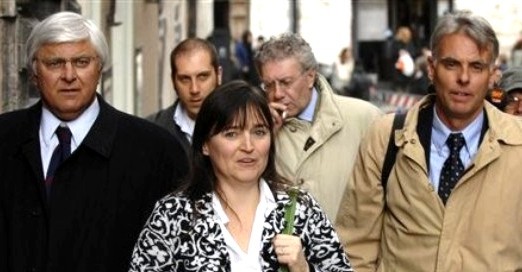
[Above: Knox’s legal team with mom back when; even then it looked like they could use some sleep]
Overview
Meeting in Seattle, Amanda Knox’S lawyer urges her to be at the Florence appeal, but his suggestion falls on deaf ears.
Here is a brief report from Italy. Clearly her lead defense lawyer Ghirga (who normally handles only small-time crime) thinks the presence of Knox and her entourage coould humanize her and allow her to speak out and to guide him.
But Knox has really been burning her bridges to Italy big-time. Let us list some of the ways in which they are now foolishly dug in so deep.
Further Law-Breaking
Since the end of trial in 2009 Amanda Knox’s entourage and she herself appear to have broken law after law after law, issuing new smears, harassing the victim’s family, having her book taken to court in Bergamo.
In Florence, how does she talk about that?
Evidence Could Strengthen
The evidence in the case as presented at trial in 2009 remains rock solid to this day (the Massei outcome is the state of play) and if the large knife is retested, it could actually get way worse. Hundreds of open questions remain which Knox has strenuously avoided answering, either on the stand or in her book or on TV.
In Florence, how does she talk about that?
Calunnias Of Justice Officials
Every instance where Amanda Knox and any of her entourage alleged without hard proof that Italian police and prosecutors have committed crimes (and there have been literally hundreds of such accusations by Preston, Fischer, on and on, now all captured and preserved) could see any or all of them hauled into court with zero heads-up (ask Sforza).
In Florence, how does she talk about that?
Framing Of Dr Mignini
In 2011 Knox was sentenced to three years (served) for the crime of framing Patrick Lumumba. So what does this slow learner do? Turn right around and commit the SAME crime in her nasty book, only this time she makes it worse. This time, she frames the chief prosecutor, in describing in detail a highly illegal interrogation that never took place.
In Florence, how does she talk about that?
Threat Of Conspiracists
There are perhaps 40 felony allegations against police and prosecution in Sollecito’s blood-money book and maybe another 20 in Knox’s own. Each of them will be put on trial separately for those claims and either one of them or both in desperation could take down all the writers, all the agents, all the publishers, all the wild-eyed conspiracists who helped write the books, and all those who made the illegal multi-million dollar deals, including their own two dads.
In Florence, how does she talk about that?
Threat Of Frank Sforza On Trial
The contempt of court trial of Frank Sforza is about to start. He is desperate to stay out of jail, and all of his alleged felonies since 2008 in contempt of the court could put him there for up to ten years. Consider the list of precisely who in Italy and the US Frank Sforza might take down, to try to give himself something of a break. This list is nothing if not long (see next post).
In Florence, how does she talk about that?
Threat Of Hellmann And Aviello
Witness Luciano Aviello is now on trial and as this post explained Aviello could take down all of the defense lawyers (for illegal dealing over the “right” judge), all of the Sollecitos, if they offered bribes, and both of the judges, Hellmann and Zanetti, who presided over the annulled appeal.
In Florence, how does she talk about that?
Conclusion
Nobody with any sense flouts the Supreme Court, or the extremely important, powerful court in Florence, which has sent down some of the toughest perps in the land.
Both courts and both prosecution teams are well-know in Italy for being cold and relentless in their search for the truth. None of the four lead lawyers for Sollecito and Knox has ever won even one case either in Florence or before the Supreme Court.
This might well be a trial balloon, to see how the Florence prosecutors and courts react. An arrest warrant, maybe? As we have seen lately, they act fast, and suddenly at any time.


